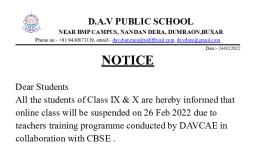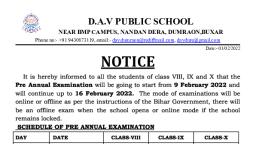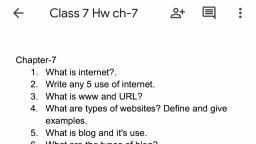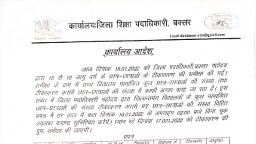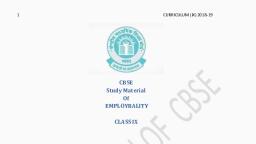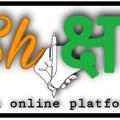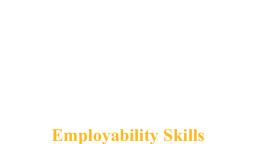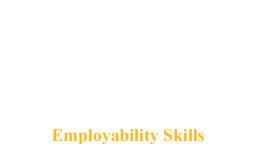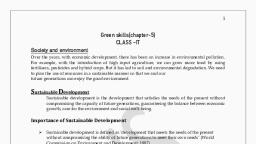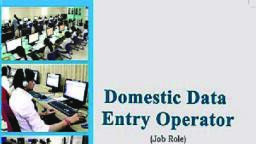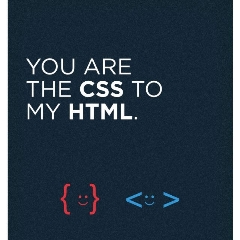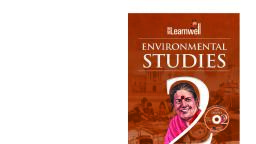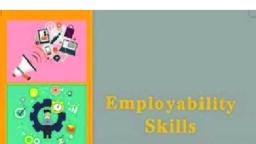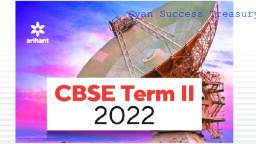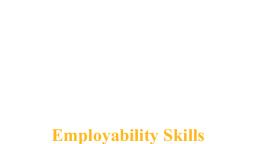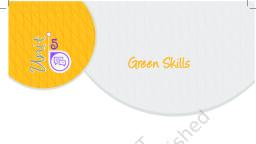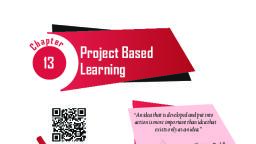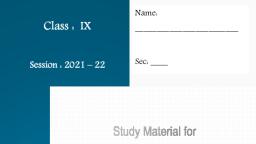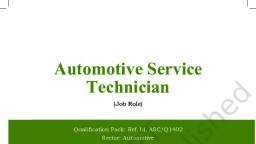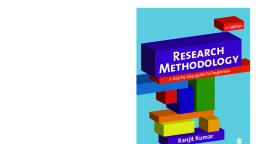Page 1 :
Employability Skills, Textbook for Class X, , Prelims.indd 1, , 31-Jan-20 9:46:12 AM
Page 2 :
ISBN 978-93-5292-218-5, First Edition, February 2020 Magha 1941, PD 5T BS, © National Council of Educational, Research and Training, 2020, , ALL RIGHTS RESERVED, No part of this publication may be reproduced, stored in a, retrieval system or transmitted, in any form or by any means,, electronic, mechanical, photocopying, recording or otherwise, without the prior permission of the publisher., This book is sold subject to the condition that it shall not,, by way of trade, be lent, re-sold, hired out or otherwise, disposed off without the publisher’s consent, in any form of, binding or cover other than that in which it is published., The correct price of this publication is the price printed on, this page. Any revised price indicated by a rubber stamp or, by a sticker or by any other means is incorrect and should, be unacceptable., OFFICES OF THE PUBLICATION, Division, NCERT, , 115.00, , NCERT Campus, Sri Aurobindo Marg, New Delhi 110 016, , Phone : 011-26562708, , 108, 100 Feet Road, Hosdakere Halli Extension, Banashankari III Stage, Bengaluru 560 085, , Phone : 080-26725740, , Navjivan Trust Building, P.O.Navjivan, Ahmedabad 380 014, , Phone : 079-27541446, , CWC Campus, Opp. Dhankal Bus Stop, Panihati, Kolkata 700 114, , Phone : 033-25530454, , CWC Complex, Maligaon, Guwahati 781 021, , Phone : 0361-2674869, , Publication Team, , Printed on 80 GSM paper with NCERT, watermark, Published at the Publication Division, by the Secretary, National Council of, Educational Research and Training,, Sri Aurobindo Marg, New Delhi 110 016, and printed at LPP Print Packaging, Pvt. Ltd., 28/1/10, Site-IV, Sahibabad, Industrial Area, Sahibabad, District, Ghaziabad (U.P.), , Prelims.indd 2, , Head, Publication, Division, , : Anup Kumar Rajput, , Chief Editor, , : Shveta Uppal, , Chief Production Officer, , : Arun Chitkara, , Chief Business Manager, , : Bibash Kumar Das, , Editor, , : Bijnan Sutar, , Production Assistant, , : Rajesh Pippal, , Cover and Layout, DTP Cell, Publication Division, , 31-Jan-20 9:46:12 AM
Page 3 :
Foreword, The National Curriculum Framework–2005 (NCF–2005) recommends, bringing work and education into the domain of the curricular, infusing it in, all areas of learning while giving it an identity of its own at relevant stages., It explains that work transforms knowledge into experience and generates, important personal and social values such as self-reliance, creativity and, cooperation. Through work one learns to find one’s place in the society. It is, an educational activity with an inherent potential for inclusion. Therefore,, an experience of involvement in productive work in an educational setting, will make one appreciate the worth of social life and what is valued and, appreciated in society. Work involves interaction with material or other, people (mostly both), thus creating a deeper comprehension and increased, practical knowledge of natural substances and social relationships., Through work and education, school knowledge can be easily linked, to learners’ life outside the school. This also makes a departure from, the legacy of bookish learning and bridges the gap between the school,, home, community and the workplace. The NCF–2005 also emphasises, on Vocational Education and Training (VET) for all those children who, wish to acquire additional skills and/or seek livelihood through vocational, education after either discontinuing or completing their school education., VET is expected to provide a ‘preferred and dignified’ choice rather than a, terminal or ‘last-resort’ option., As a follow-up of this, NCERT has attempted to infuse work across, the subject areas and also contributed in the development of the National, Skill Qualification Framework (NSQF) for the country, which was, notified on 27 December 2013. It is a quality assurance framework that, organises all qualifications according to levels of knowledge, skills and, attitude. These levels, graded from one to ten, are defined in terms of, learning outcomes, which the learner must possess regardless of whether, they are obtained through formal, non-formal or informal learning., The NSQF sets common principles and guidelines for a nationally, recognised qualification system covering Schools, Vocational Education, and Training Institutions, Technical Education Institutions, Colleges, and Universities., It is under this backdrop that Pandit Sunderlal Sharma Central Institute, of Vocational Education (PSSCIVE), Bhopal, a constituent of NCERT has, developed learning outcomes based modular curricula for the vocational, , Prelims.indd 3, , 31-Jan-20 9:46:12 AM
Page 4 :
subjects from Classes IX to XII. This has been developed under the, Centrally Sponsored Scheme of Vocationalisation of Secondary and Higher, Secondary Education of the Ministry of Human Resource Development., This textbook takes care of generic skills embedded in various job roles, in a comprehensive manner and also provides more opportunities and, scope for students to engage with these common and necessary skills,, such as communication, critical thinking and decision making in different, situations pertaining to different job roles., I acknowledge the contribution of the development team, reviewers, and all the institutions and organisations, which have supported in the, development of this textbook., NCERT would welcome suggestions from students, teachers and, parents, which would help us to further improve the quality of the material, in subsequent editions., , Hrushikesh Senapaty, Director, New Delhi , National Council of Educational, June 2018 , Research and Training, , (iv), , Prelims.indd 4, , 31-Jan-20 9:46:12 AM
Page 5 :
About the Textbook, Employability skills can be defined as those soft skills which employers, look for in a potential employee. These skills equip the employees to, carry out their role to the best of their ability and client satisfaction. For, example, the ability to explain what you mean in a clear and concise way, through written and spoken means, helps to build a better relationship, with the client or the customer. Similarly, handling stress that comes with, deadlines for finishing work and ensuring that you meet the deadlines can, be done through effective self-management training. It can also be done, by working well with other people from different disciplines, backgrounds,, and expertise to accomplish a task or goal. In today’s digital age, employers, expect that the employees should be able to make use of elementary, functions of information and communication technology to retrieve,, access, store, produce, present and exchange information in collaborative, networks via the Internet. Students need to develop entrepreneurial skills,, so that they can develop necessary knowledge and skills to start their own, business, thus becoming job creators rather than job seekers. Potential, employees need to develop green skills, which are the technical skills,, knowledge, values and attitudes needed in the workforce to develop and, support sustainable social, economic and environmental outcomes in, business, industry and the community. Thus, as a student you are expected, to acquire a range of skills so that you can meet the skill demands of the, organisation that you would work for or to set up and run your own business., This textbook on ‘Employability Skills’ covers communication,, self-management,, information, and, communication, technology,, entrepreneurial and green skills. It has been developed as per the learning, outcome based curriculum. The employability skills are embedded in the, Qualification Packs of the different job roles in various sectors under the, National Skill Qualification Framework., The textbook aims to provide learning experience through a blended, approach of text and video-based interactive e-learning lessons. Running, these e-learning lessons in classrooms would require a computer with, Internet connection, projector and sound system, which the school should, , Prelims.indd 5, , 31-Jan-20 9:46:12 AM
Page 6 :
provide to the teachers and students. The teachers will guide you to actively, participate in class — asking and answering questions and following the, instructions to complete the exercises and activities., Vinay Swarup Mehrotra, Professor and Head, Curriculum Development and Evaluation Centre, and NSQF Cell,, PSS Central Institute of Vocational Education, Bhopal, , (vi), , Prelims.indd 6, , 31-Jan-20 9:46:12 AM
Page 7 :
Acknowledgements, The National Council of Educational Research and Training (NCERT), expresses its gratitude to all members of the Project Approval Board, (PAB) and officials of the Ministry of Human Resource Development, (MHRD), Government of India, for their cooperation in the development, of this textbook. The Council would like to thank Rajesh P. Khambayat,, Joint Director, PSS Central Institute of Vocational Education (PSSCIVE),, Bhopal for providing support and guidance in the development of, this textbook., The Council extends its gratitude to Vinay Swarup Mehrotra, Professor, and Head, Department of Agriculture and Animal Husbandry and, Curriculum Development and Evaluation Centre, PSSCIVE, Bhopal, for, his untiring efforts, skillful guidance and assistance in the development, and publishing of this textbook. The Council is grateful to Saroj Yadav,, Professor and Dean (Academic), NCERT, and Ranjana Arora, Professor and, Head, Department of Curriculum Studies, NCERT for their sincere efforts, in coordinating the review workshops for the finalisation of this textbook., The Council acknowledges the contribution of the following review, committee members from PSSCIVE — Abhijit Nayak, Professor and Head,, Department of Health and Paramedical, Dipak Shudhalwar, Associate, Professor and Head, Department of Engineering and Technology, Kuldeep, Singh, Associate Professor, Department of Agriculture and Animal, Husbandry, Mridula Saxena, Professor, Department of Home Science and, Hospitality Management, P. Veeraiah, Professor and Head, Department of, Business and Commerce, Pinki Khanna, Professor and Head, Department, of Home Science and Hospitality Management, Rajiv Pathak, Professor,, Department of Agriculture and Animal Husbandry, Saurabh Prakash,, Professor, Department of Engineering and Technology, R.K. Shukla,, Professor, Department of Business and Commerce and Vipin K. Jain,, Associate Professor and Head, Department of Humanities, Science,, Education and Research for reviewing this textbook., The Council also acknowledges the valuable contribution of, Aakash Sethi, Chief Executive Officer, Quest Alliance, Aditi Kumar,, Project Manager, Quest Alliance, Amit Singh, Advisor, National Institute, for Entrepreneurship and Small Business Development, Austin Thomas,, Executive Vice President, Wadhwani Foundation, Mekin Maheshwari, Chief, Executive Officer, Udhyam Learning Foundation, Nidhi Sahni, Curriculum, , Prelims.indd 7, , 31-Jan-20 9:46:12 AM
Page 8 :
Manager, Wadhwani Foundation, Nikita Bengani, Senior Program, Manager, Quest Alliance, Poonam Sinha, Joint Director, National Institute, for Entrepreneurship and Small Business Development, Rohit Massey,, Consultant, National Institute for Entrepreneurship and Small Business, Development, Shivani Gandhi, Program Manager, Udhyam Learning, Foundation, Sonal K Jain, Consultant, Wadhwani Foundation, Sunil, Dahiya, Executive Vice President, Wadhwani Foundation, and Vikrant, Chandela, Associate Director, Wadhwani Foundation for their assistance, in development of the textbook and for providing illustrations for the, textbook. Vikas Kogey, Visual Analyser and Pinki Tiwari, Graphic Designer,, PSSCIVE, Bhopal are also duly acknowledged for redrawing illustrations, for the textbook. The images other than these used in the textbook have, been sourced from the Creative Commons License., The Council also acknowledges the copyediting and valuable, contribution of Shilpa Mohan, Assistant Editor (Contractual) Publication, Division, NCERT, in shaping this textbook., The efforts of Pawan Kumar Barriar, DTP Operator and Sachin Tanwar,, DTP Operator (Contractual), Publication Division, NCERT, for flawless, layout design are also acknowledged., , (viii), , Prelims.indd 8, , 31-Jan-20 9:46:12 AM
Page 9 :
Contents, Foreword, , iii, , About the Textbook, , v, , Unit 1, , Communication Skills, , 1, , Session 1, , Methods of Communication, , 1, , Session 2, , Verbal Communication, , 7, , Session 3, , Non-verbal Communication, , 10, , Session 4, , Communication Cycle and Importance of Feedback, , 16, , Session 5, , Barriers to Effective Communication, , 20, , Session 6, , Writing Skills — Parts of Speech, , 24, , Session 7, , Writing Skills — Sentences, , 31, , Unit 2, , Unit 3, , Unit 4, , Unit 5, , Prelims.indd 9, , Self-management Skills, , 39, , Session 1, , Stress Management, , 40, , Session 2, , Self-awareness — Strength and Weakness Analysis, , 46, , Session 3, , Self-motivation, , 51, , Session 4, , Self-regulation — Goal Setting, , 54, , Session 5, , Self-regulation — Time Management, , 58, , Information and Communication Technology Skills, , 63, , Session 1, , Basic Computer Operations, , 63, , Session 2, , Performing Basic File Operations, , 70, , Session 3, , Computer Care and Maintenance, , 74, , Session 4, , Computer Security and Privacy, , 79, , Entrepreneurial Skills, , 84, , Session 1, , Entrepreneurship and Society, , 85, , Session 2, , Qualities and Functions of an Entrepreneur, , 89, , Session 3, , Myths about Entrepreneurship, , 94, , Session 4, , Entrepreneurship as a Career Option, , 99, , Green Skills, , 103, , Session 1, , Sustainable Development, , 103, , Session 2, , Our Role in Sustainable Development, , 109, , Answer Key, , 114, , Glossary, , 117, , 31-Jan-20 9:46:12 AM
Page 10 :
Prelims.indd 10, , 31-Jan-20 9:46:13 AM
Page 11 :
Unit, , 1, , Communication, Skills, , Introduction, In the present time, a thorough knowledge, of language with communication skills, is very important in any occupation or, business. As a student, you may study, any language, but it is important that you, are able to read, write, speak and listen, well in order to communicate properly., Speaking more than one language can, help you to communicate well with people, around the world. Learning English can, help you to communicate with people who, understand English besides the mother, tongue i.e., the language one has been, exposed to since birth., , Session 1: Methods, , of, , Communication, , The word ‘communication’ comes from the Latin word, commūnicāre, meaning ‘to share’., Being able to communicate effectively is one of the, most important life skills. Communication skills are, , Unit 1.indd 1, , 31-Jan-20 9:48:05 AM
Page 12 :
Notes, , needed to communicate effectively with people and, customers. This module aims to help you improve your, communication skills., Clear and concise communication is of immense, importance in work and business environment as there, are several parties involved. Various stakeholders, like,, customers, employees, vendors, media, etc., are always, sending important information to each other., Communication has three important parts:, 1. Transmitting — The, sender, transmits, message through one medium or another., , the, , 2. Listening — The receiver listens or understands, the message., 3. Feedback — The, receiver, conveys, their, understanding of the message to the sender in the, form of feedback to complete the communication, cycle., Let us look at an example below in an outlet of a, bookstore:, Customer (to a retail associate): Do you have the, textbook of Beauty Therapist, published by National, Council of Educational Research and Training?, Salesperson : Let me check., In the above conversation, the information is being, transmitted orally by the customer. The salesperson is, the listener in this case. The discussion about book is, the message., Salesperson: Yes, we have the textbook of Beauty, Therapist., Customer: Please give me one copy of the textbook., I want to purchase it., In the above conversation, the receiver’s response, (i.e., the salesperson) is the feedback. This is an, example of a communication between the customer and, the salesperson., The process of conveying a message is complete, only when the person receiving it has understood the, message in its entirety. In this case, the customer, understood that the book store has the textbook and, they can get a copy of the same., 2, , Unit 1.indd 2, , Employability Skills – Class X, , 31-Jan-20 9:48:05 AM
Page 13 :
Communication Process and Elements, Let us see the process of communication in detail., Information/, Input, , Behaviour/, Output, , The Channel—, speaking, writing, graphic, video, etc., , What, I mean, , Coding, , The, Messenger, , What, I understand, , The Message De-coding, , The, Recepient, , At least some, code in common, Fig. 1.1: Communication Process, , Sender sends a, message, , Giving Information, , Message, (Encoding) channel, Sender, , A Channel is, used to transfer, the message, , Communication, starts with, sender, , Receiver, , Reply to Sender, (Encoding), Receiver, replies to the, sender, , channel, , Message is, received by the, receiver, , Receiving Information, , Figure 1.2: Elements of Communication, , Communication Skills, , Unit 1.indd 3, , 3, , 31-Jan-20 9:48:06 AM
Page 14 :
The various elements of a communication cycle are:, Sender: the person beginning the communication., Message: the information that the sender wants to, convey., Channel: the means by which the information is sent., Receiver: the person to whom the message is sent., Feedback: the receiver’s acknowledgement and response, to the message., We are constantly use some form of communication or, another to send a message across. Without the different, methods of communication available today, it would be, challenging to carry out business as proficiently as it is, done today and with the same swiftness. Some common, methods of communication are given in Table 1.1., Table 1.1: Methods of Communication, Method, Face-to-face informal, communication, , There is nothing better than face-to-face, communication. It helps the message, to be understood clearly and quickly., Also, since body language can be seen, in this case; it adds to the effectiveness, of the communication., , e-mail, , e-mail can be used to communicate, quickly with one or many individuals, in various locations. It offers flexibility,, convenience and low-cost., , Notices/Posters, , It is effective when the same message, has to go out to a large group of, people. Generally used for where email, communication may not be effective., For example, ‘Change in the lunch time, for factory worker,’ or ‘XYZ Clothing, will remain closed for customers on, Sunday.’, Communication, during, business, meetings at an organisation are generally, addressed to a group of people. It can, be related to business, management, and organisational decisions., , Business Meetings, , 4, , Unit 1.indd 4, , Description, , Pictorial Description, , Employability Skills – Class X, , 31-Jan-20 9:48:12 AM
Page 15 :
Other Methods, , There can be various other methods, like social networks, message, phone, call for communication, newsletter,, blog, etc., , Choosing the right method of communication, depends on, • target audience, • costs, • kind/type of information, • urgency/priority, The methods of communication you choose could affect, your relationship with peers, supervisors and customers., It is, therefore, vital that you spend considerable time, and consider all factors choosing the right methods to, aid you in your tasks., , Practical Exercises, The teacher will facilitate these activities by showing you the, e-learning lesson at http://www.psscive.ac.in/stud_text_book., html. This will include videos and e-content for the above topics, as well as detailed instructions for some activities below., Initial Thinking Activity, After watching the initial video in the e-learning lesson for, this topic, write the answer of the following question: Why is it, important to communicate effectively?, Activity 1, Role Play on Communication, Procedure, • Form groups with four students in each group., • The situation is that a student is Sales Executive at a, toy store and he or she is supposed to communicate to, customers about the various types of toys available with, the store for different age group., • The other students will reach the Sales Executive one by, one and ask different types of questions related to toys., • Develop a script for the role play and act on the same., • Discuss what you all learned from this activity., Communication Skills, , Unit 1.indd 5, , 5, , 31-Jan-20 9:48:14 AM
Page 16 :
Notes, , Activity 2, Identifying Elements of the Communication Cycle in Activity 1, Material required, Paper and pencil, Procedure, • Each student will draw a communication cycle., • The entire class will then discuss how each element, affected communication during Activity 1., , Check Your Progress, A. Multiple choice questions, Read the questions carefully and circle the letter(s) (a),, (b), (c) or (d) that best answer(s) the question. (Note: There, can be more than one correct choice), 1., , Which of the following is NOT an element of communication, within the communication process cycle?, (a) Channel, (b) Receiver, (c) Sender, (d) Time, 2. You need to apply leave at work? Which method of, communication will you use?, (a) e-mail, (b) Poster, (c) Newsletter, (d) Blog, 3. By which action can senders send their messages?, (a) Gestures, (b) Speaking, (c) Reading, (d) Writing, B. Subjective question, 1., , Make a chart highlighting all the methods of, communication. Use markers and colours to highlight, differences amongst all., , What Have You Learnt?, After this session, you will be able to, • identify the different communication elements., • explain the communication process along with all the, communication elements., • list the various methods of communication., 6, , Unit 1.indd 6, , Employability Skills – Class X, , 11-Feb-20 9:35:19 AM
Page 17 :
Session 2: Verbal Communication, Verbal communication includes sounds, words,, language, and speech. Speaking is one of the most, effective and commonly used way of communicating. It, helps in expressing our emotions in words. By improving, your verbal communication skills you will build rapport,, and have a better connect. Table 1.2 lists the important, forms of verbal communication., Table 1.2: Verbal Communication, Type of Verbal, Communication, , Examples, , This form of communication takes, place between two individuals and is, thus a one-on-one conversation. It, can be formal or informal., Examples, 1. A manager discussing the, performance with an employee., 2. Two friends discussing, homework., 3. Two people talking to each other, over phone or video call., form, of, communication, Written Communication This, involves writing words. It can be, letters, circulars, reports, manuals,, SMS, social media chats, etc. It can, be between two or more people., Examples, 1. A manager writing an, appreciation e-mail to an, employee., 2. Writing a letter to grandmother, enquiring about health., Interpersonal, Communication, , Small Group, Communication, , Communication Skills, , Unit 1.indd 7, , This type of communication takes, place when there are more than two, people involved. Each participant, can interact and converse with, the rest., Examples, 1. Press conferences, 2. Board meetings, 3. Team meetings, 7, , 31-Jan-20 9:48:25 AM
Page 18 :
Public Communication, , This type of communication takes, place when one individual addresses, a large gathering., Examples, 1. Election campaigns, 2. Public speeches by dignitaries, , Advantages of Verbal Communication, It is an easy mode of communication in which you, can exchange ideas by saying what you want and get, a quick response. Verbal communication also enables, you to keep changing your interaction as per the other, person’s response., , Disadvantages of Verbal Communication, Since verbal communication depends on written or spoken, words, sometimes the meanings can be confusing and, difficult to understand if the right words are not used., , Mastering Verbal Communication, Most people tend to get nervous while speaking in front, of a large group, or even while speaking to their teachers,, managers or supervisors. However, if you focus on the, points given in Table 1.3, you can enhance and master, your verbal communication skills., Table 1.3: Mastering Verbal Communication, Think Before You • Think about your topic., • Think about the most effective ways to make your listeners, Speak, understand the topic., • Write or note down whatever you plan to say., Concise and Clear • Speak clearly, loudly and at moderate speed., • Be sure the information you want to share is to the point., • Do not repeat the same sentences., • Be confident., Confidence and, • Maintain eye contact, stand straight and be attentive., Body Language, • Be friendly., , Practical Exercise, The teacher will facilitate these activities by showing you the, e-Learning lesson at http://www.psscive.ac.in/stud_text_book., html. This will include videos and e-content for the above topics, as well as detailed instructions for some activities below., 8, , Unit 1.indd 8, , Employability Skills – Class X, , 11-Feb-20 9:36:45 AM
Page 19 :
Initial Thinking Activity, After watching the video in the e-Learning lesson for this topic write, down why do you think Tina’s directions were misunderstood?, How would you have given directions on the phone?, , Notes, , Activity 1, Group-Practice: Role Play of a Telephonic Conversation, Material required, Notebook, pen, Procedure, • Form groups with three students in each group., • Write a phone conversation based on a given scenario of a, student calling a university academic coordinator to know, about study courses and admission procedure., • One student acts as caller and the other as receiver., • Read out the conversation by enacting the roles., • The third student gives feedback based on the 7Cs of, communication (clear, concise, concrete, correct, coherent,, complete and courteous)., Activity 2, Group-Practice on Public Speaking, Material required, Notebook, pen, Procedure, • Form groups with three students in each group., • Within the group, choose a topic for a short speech., For example, Importance of Punctuality, Healthy Food, Habits, etc., • Each person should make a speech to the others in the, group; who then give feedback based on whether the, person was able to communicate properly., • One student from the group volunteers to give the same, speech in front of the class., , Check Your Progress, A. Multiple choice questions, Read the questions carefully and circle the letter (a), (b),, (c) or (d) that best answers the questions., 1., , Which of the following, communication?, (a) Newspapers, (b) Letters, (c) Phone call, (d) e-mail, , Communication Skills, , Unit 1.indd 9, , is, , an, , example, , of, , oral, , 9, , 11-Feb-20 9:37:08 AM
Page 20 :
Notes, , 2., , What are the types of words we should use for, verbal communication?, (a) Acronyms, (b) Simple, (c) Technical, (d) Jargons, 3. Why do we use e-mails?, (a) To communicate with many people at the same time., (b) To share documents and files., (c) To talk to each other in real-time., (d) To keep a record of communication., , B. Subjective question, 1., , List the different types of verbal communication., Include examples for each verbal communication type., , What Have You Learnt?, After completing this session, you will able to, • describe different types of verbal communication., • list the advantages and disadvantages of, communication., , verbal, , Session 3: Non-verbal Communication, Non-verbal communication is the expression or, exchange of information or messages without using any, spoken or written word., In other words, we send signals and messages to, others, through expressions, gestures, postures, touch,, space, eye contact and para language. In this session,, , Figure1.3: Non-verbal Communication, , 10, , Unit 1.indd 10, , Employability Skills – Class X, , 31-Jan-20 9:48:27 AM
Page 21 :
you will learn about the importance of different types, of non-verbal communication skills and also know the, correct body language to be used for communication., , Importance of Non-verbal Communication, In our day-to-day communication, • 55% communication is done using body, movements, face, arms, etc., • 38% communication is done using voice, tone,, pauses, etc., • only 7% communication is done using words., , Figure 1.4: Methods of Communication, , As we can see in Figure 1.4, around 93% of our, communication is non-verbal. Certain examples of, communicating with tone of voice and body language, are shown in Table 1.4., Table 1.4: Non-verbal Communication, Non-Verbal Communication, Gestures, , • Raising a hand to greet or say goodbye, • Pointing your finger at someone, , Expressions, , • Smiling when you are happy, • Making a sad face when you are sad, , Communication Skills, , Unit 1.indd 11, , 11, , 31-Jan-20 9:48:33 AM
Page 22 :
Body Language, , Postures by which attitudes and feelings, are communicated. Standing straight,, showing interest., , •, , Our message becomes more effective if we use the, right gestures while communicating., • If we know about non-verbal communication,, we can understand our audience’s reaction and, adjust our interaction accordingly., • Using the right gestures and postures is a sign of, professionalism and etiquette., • If verbal messages are obstructed by noise or, distance, etc., we can use our hand movements to, exchange messages. For example, placing a finger, on the lips indicates the need for silence while, nodding the head is the same as saying ‘yes’., As mentioned in Table 1.5, let us learn about some, of the ways in which we communicate non-verbally., Table 1.5: Types of Non-verbal Communication, Type, Facial Expressions, , Posture, , Gestures or, Body Language, , 12, , Unit 1.indd 12, , What it means, , How to use effectively?, , Our expressions can show different • Smile when you, feelings, such as Happiness,, meet someone., Sadness, Anger, Surprise, Fear, etc. • Keep your face relaxed., • Match your expressions, with your words., • Nod while listening., Postures show our confidence and, • Keep your shoulders, feelings. For example, a straight, straight and body relaxed., body posture shows confidence, • Sit straight while resting, while a slumped posture is a sign of, your hands and feet in, weakness., relaxed position., • While standing, keep your, hands by your sides., Gestures include body movements, • Keep your hands open., that express an idea or meaning., • Avoid pointing your finger, For example, raising a hand in, at people., class to ask a question and biting, • Tilt your head a bit to show, nails when nervous., that you are attentive., , Employability Skills – Class X, , 31-Jan-20 9:48:40 AM
Page 23 :
Touch, , We communicate a great deal, through touch. For example,, a firm handshake to display, confidence and pat on the back, to encourage someone., , • Shake hands firmly while, meeting someone., • Avoid other touch, gestures during formal, communication., , Space, , Space is the physical distance, between two people. The space, between tow persons while, communicating, generally depends, on the intimacy or closeness, between them., , • Maintain proper space, depending on the, relationship, which could, be formal or informal or, the closeness with the, person with whom you, are talking., , Eye Contact, , The way we look at someone can, communicate a lot. Eye contact, shows that we are paying attention, to the person as opposed to looking, away, which can make the other, person feel ignored., How we speak affects our, communication and includes the, tone, speed and volume of our, voice. For example, talking fast, may show happiness, excitement or, nervousness while speaking slow, may show seriousness or sadness., , • Look directly at the person, who is speaking., • Avoid staring; keep a, relaxed look., • Maintain eye contact with, intermittent breaks., • Use a suitable tone, and volume, • Maintain a moderate speed, while talking, , Paralanguage, , Visual Communication, Visual communication proves to be effective since it, involves interchanging messages only through images, or pictures and therefore, you do not need to know any, particular language for understanding it. It is simple, and remains consistent across different places. Some, common types of visual communication are shown in, Table 1.6., Table 1.6: Examples of Visual Communication, Visual Communication: Exchanging Information through Images, Under construction, , Communication Skills, , Unit 1.indd 13, , No pets allowed, , 13, , 31-Jan-20 9:48:50 AM
Page 24 :
No parking zone, , No entry, , Danger warning, , Radiation/biohazard, warning, , Under CCTV surveillance, , No mobile phone, , Practical Exercises, The teacher will facilitate these activities by showing you the, e-learning lesson at http://www.psscive.ac.in/stud_text_book., html. This will include videos and e-content for the above topics, as well as detailed instructions for some activities below., Initial Thinking Activity, After watching the initial video in the e-learning lesson for this, topic write down how could Rohit understand something was, wrong with Amar? Can you understand how your friends are, feeling even when they do not tell you anything?, Activity 1, Group-Practice: Role-play on Non-verbal Communication, Material required, Notebook, pen, Procedure, • Form groups with three students in each group., • Prepare the script for the role play, based on the given, scenario. For example, a hearing impaired salesperson is, attending a female customer at an apparel store., • Act it out in front of your group., • One group volunteers to act before your whole class., Discuss how students used non-verbal communication., Was this communication effective?, , 14, , Unit 1.indd 14, , Employability Skills – Class X, , 31-Jan-20 9:49:01 AM
Page 25 :
Activity 2, , Notes, , Group-Practice: How to Avoid Body Language Mistakes, Material required, Notebook, pen, Procedure, • In the same group of three students as above, discuss what, are the Dos and Don’ts of avoiding miscommunication, because of body language., • Each student should write down a list of these Dos and, Don’ts. (Prepare the lists as homework, if there is less time, left to complete the task in class)., Activity 3, Individual-Practice: Comparing Methods of Communication, Material required, Notebook, pen, Procedure, • Discuss the three methods of communication (Verbal,, Non-verbal and Visual)., • Ask each student to write a list of the advantages and, disadvantages of each method., • Practice: In all your conversations at home and school,, pay attention to the non-verbal signs others are using., Practice using the non-verbal methods you learnt here in, the right manner., , Check Your Progress, A. Multiple choice questions, Read the questions carefully and circle the letter (a), (b),, (c) or (d) that best answers the question., 1., , Which of these is a positive (good) facial expression?, (a) Frowning while concentrating, (b) Maintaining eye contact, (c) Smiling continuously, (d) Rolling up your eyes, 2. What does an upright (straight) body posture convey, or show?, (a) Pride, (b) Professionalism, (c) Confidence, (d) Humility, 3. Which of these is NOT an appropriate non-verbal, communication at work?, (a) Keeping hands in pockets while talking, (b) Talking at moderate speed, Communication Skills, , Unit 1.indd 15, , 15, , 31-Jan-20 9:49:01 AM
Page 26 :
Notes, , (c) Sitting straight, (d) Tilting head a bit to listen, 4. Which, of, the, following, statement, is, true, about communication?, (a) 50% of our communication is non-verbal, (b) 20% communication is done using body movements,, face, arms, etc., (c) 5% communication is done using voice, tone,, pauses, etc., (d) 7% communication is done using words, 5. Put a X mark against the actions below which are, examples of bad non-verbal communication., • Laughing during formal communication, • Scratching head, • Smiling when speaking to a friend, • Nodding when you agree with something, • Standing straight, • Yawning while listening, • Sitting straight, • Maintaining eye contact while speaking, • Biting nails, • Firm Handshake, • Clenching jaws, • Looking away when someone is speaking to you, • Intense stare, B. Subjective question, 1., , Draw any five common signs used for Visual, Communication. Explain what each conveys and where, did you see it?, , What Have You Learnt?, After completing this session, you will be able to, • explain non-verbal and visual communication and, their importance., • identify different types of non-verbal communication., • use non-verbal communication in the right manner at work., • avoid common mistakes in non-verbal communication., , Session 4: Communication Cycle, Importance of Feedback, , and, , Feedback is an important part of the communication, cycle. For effective communication, it is important, that the sender receives an acknowledgement from, 16, , Unit 1.indd 16, , Employability Skills – Class X, , 31-Jan-20 9:49:01 AM
Page 27 :
the receiver about getting the message across., While a sender sends information, the receiver, provides feedback on the received message., Translated to the work environment, when you, observe someone perform their work and then,, communicate with them to help improve their, performances, you are giving feedback. Feedback, can be positive or negative. A good feedback is always, • specific, • helpful, • kind, , Figure 1.5: Communication Cycle, , Table 1.5: Types of Feedback, Type of Feedback, , Examples, , Positive Feedback, , • I noticed you finished the work, perfectly. Great job!, • I really appreciate you taking that, call. Can you please also share, the details?, , Negative Feedback, , • You keep forgetting to smile at the, hotel guests when you talk, to them., • You take really long to reply to, e-mails! Are you always so busy?, , No Feedback, , • It is also a feedback in itself which, indicates disagreement of ideas., , Feedback, Feedback, if shared properly, can help reinforce existing, strengths and can increase the recipient’s abilities to, Communication Skills, , Unit 1.indd 17, , 17, , 31-Jan-20 9:49:18 AM
Page 28 :
Notes, , rectify errors. It can have a long-term effect in managing, and achieving goals., A good feedback is one that is:, • Specific: Avoid general comments. Try to, include examples to clarify your statement., Offering alternatives rather than just giving, advice allows the receiver to decide what to do, with your feedback., • Timely: Being prompt is the key, since feedback, loses its impact if delayed for too long., • Polite: While it is important to share feedback,, the recipient should not feel offended by the, language of the feedback., • Offering continuing support: Feedback sharing, should be a continuous process. After offering, feedback, let recipients know you are available, for support., , Importance of Feedback, Feedback is the final component and one of the most, important factors in the process of communication since, it is defined as the response given by the receiver to, the sender. Let us look at certain reasons why feedback, is important., • It validates effective listening: The person, providing the feedback knows they have been, understood (or received) and that their feedback, provides some value., • It motivates: Feedback can motivate people to, build better work relationships and continue the, good work that is being appreciated., • It is always there: Every time you speak to, a person, we communicate feedback so it is, impossible not to provide one., • It boosts learning: Feedback is important to, remain focussed on goals, plan better and develop, improved products and services., • It improves performance: Feedback can, help to form better decisions to improve and, increase performance., , 18, , Unit 1.indd 18, , Employability Skills – Class X, , 31-Jan-20 9:49:18 AM
Page 29 :
Practical Exercise, , Notes, , The teacher will facilitate these activities by showing you the, e-learning lesson at http://www.psscive.ac.in/stud_text_book., html. This will include videos and e-content for the above topics, as well as detailed instructions for some activities below., Activity 1, Role Play on Providing Feedback, Material required, Notebook, pen, Procedure, • Form groups with five students in each group., • Two volunteers in the group should act out a role play, of a hotel staff. For example, Volunteer A can act as a, front desk executive and Volunteer B as a guest enquiring, availability of rooms., • After the role play, remaining members of group will give, constructive feedback to both the volunteers., Activity 2, Group-Practice on Constructive Feedback, Material required, Notebook, pen, Procedure, • Form groups with five students in each group., • Each member in the group should write down three, sentences showing how feedback should NOT be given., • Then, each group forms a circle. One person in the circle, starts by saying a sentence or feedback. The next person, in the circle tries to make the feedback more constructive., • Keep repeating until all written feedback have, constructive alternatives., , Check Your Progress, A. Multiple choice questions, Read the questions carefully and circle the letter (a), (b),, (c) or (d) that best answers the question., 1., , Which of these are examples of positive feedback?, (a) Excellent, your work has improved., (b) I noticed your dedication towards the project., (c) You are always doing it the wrong way., (d) All of the above, , Communication Skills, , Unit 1.indd 19, , 19, , 31-Jan-20 9:49:18 AM
Page 30 :
Notes, , 2., , Which of these are examples of negative feedback?, (a) I hate to tell you this but your drawing skills are poor., (b) You can surely improve your drawing., (c) This is a good drawing but you can do better., (d) None of the above, 3. Which of the following are effective components of a good, feedback?, (a) Detailed and time consuming, (b) Direct and honest, (c) Specific, (d) Opinion-based, B. Subjective question, 1., , What do you mean by feedback? Let’s take a scenario., Radha is your co-worker. Together you are making a, report on how to manage the waste in your store. Since, she has not finished her part of the report on time, the, whole report has got delayed and the manager has given, you both a warning. Write down the feedback you would, like to give your co-worker on managing time. Try to keep, the feedback specific and polite., , What Have You Learnt?, After completing this session, you will able to, • identify how and when to give feedback., • explain the importance of feedback., • use suitable words and phrases when giving or receiving, feedback., , Session 5: Barriers, Communication, , to, , Effective, , What is Effective Communication?, We now know that there are different methods of, communication: non-verbal, verbal and visual. However,, all these methods can only be effective if we follow the, basic principles of professional communication skills., These can be abbreviated as 7 Cs i.e., Clear, Concise,, Concrete, Correct, Coherent, Complete and Courteous., These are further explained in Figure 1.6., Absence of any of these 7Cs can lead to, miscommunication. Let us take a closer look at certain, barriers to effective communication., 20, , Unit 1.indd 20, , Employability Skills – Class X, , 31-Jan-20 9:49:18 AM
Page 31 :
Notes, , Figure 1.6: 7Cs of Effective Communication, , Linguistic, , Cultural, , Barriers to, Communication, Physical and, Organisational, , Interpersonal, , Figure 1.7: Barriers to Effective Communication, , Barriers to Effective Communication, Physical Barriers, Physical barrier is the environmental and natural, condition that act as a barrier in communication in, sending message from sender to receiver. Not being, able to see gestures, posture and general body language, can make communication less effective. For example,, text messages are often less effective than face-to-face, communication., , Linguistic Barriers, The inability to communicate using a language is known, as language barrier to communication. Language, barriers are the most common communication, barriers, which cause misunderstandings and, Communication Skills, , Unit 1.indd 21, , 21, , 31-Jan-20 9:49:20 AM
Page 32 :
Notes, , misinterpretations between people. For example,, slang, professional jargon and regional colloquialisms, can make communication difficult., , Interpersonal Barriers, Barriers to interpersonal communication occur when, the sender’s message is received differently from how, it was intended. It is also very difficult to communicate, with someone who is not willing to talk or express their, feelings and views. Stage fear, lack of will to communicate,, personal differences can create interpersonal barriers, to communication., , Organisational Barriers, Organisations are designed on the basis of formal, hierarchical structures that follow performance, standards, rules and regulations, procedures, policies,, behavioural norms, etc. All these affect the free flow, of communication in organisations and therefore,, need to be suitably managed. Superior-subordinate, relationships in a formal organisational structure can be, a barrier to free flow of communication. Also, sometimes, due to the stringent rules, the employees find it difficult, to communicate with their peers too., , Cultural Barriers, Cultural barriers is when people of different cultures are, unable to understand each other’s customs, resulting in, inconveniences and difficulties.People sometimes make, stereotypical assumptions about others based on their, cultural background, this leads to difference in opinions, and can be a major barrier to effective communication., Although there are certain barriers to effective, communication, you can always overcome these, barriers by following some best practices of effective, communication that are listed here., , Ways to Overcome Barriers to Effective, Communication, •, •, 22, , Unit 1.indd 22, , Use simple language, Do not form assumptions on culture, religion, or geography, Employability Skills – Class X, , 31-Jan-20 9:49:20 AM
Page 33 :
•, •, •, •, , Try to communicate in person as much as possible, Use visuals, Take help of a translator to overcome differences, in language, Be respectful of other’s opinions, , Notes, , Practical Exercise, Activity 1, Role Play on Barriers to Effective Communication., Material required, Notebook, pen, Procedure, • Form groups with five students in each group., • Two volunteers from the group should act out a role play of, a salesperson in a shopping mall. For example, Volunteer, A can act as a sales executive, and Volunteer B as a, customer enquiring about a television set. The customer, is from a foreign country., • Enact the communication barriers or challenges the, customer or salesperson may face while interacting with, each other., Activity 2, Group practice: Overcoming Barriers, Material required, Notebook, pen, Procedure, • Form groups with five students in each group., • Each member in a group should write down three ways, to overcome barriers to effective communication. The, group members will then stand in a circle. Each student, should say aloud one point each; till all the ways have, been discussed., , Check Your Progress, A. Multiple choice questions, Read the questions carefully and circle the letter(s) (a),, (b), (c) or (d) that best answers the question., 1. Which of these is NOT a common communication barrier?, (a) Linguistic barrier, (b) Interpersonal barrier, , Communication Skills, , Unit 1.indd 23, , 23, , 31-Jan-20 9:49:20 AM
Page 34 :
Notes, , (c) Financial barrier, (d) Organisational barrier, 2. Which of these are ways to overcome communication, barriers?, (a) Respecting each other’s differences, (b) Using a translator, (c) Not communicating at all, (d) Using your own language for comfort, B. Subjective question, 1. Write down the common communication barriers you, may come across when you move to a new city or country., , What Have You Learnt?, After completing this session, you will be able to, • identify the common barriers to effective communication., • list ways to overcome barriers to effective communication., , Session 6: Writing Skills — Parts of Speech, Writing skills are part of verbal communication and, include e-mails, letters, notes, articles, SMS/chat,, blogs, etc. In all these forms of written communication,, we use sentences to express ourselves. Sentences, are important because they help to clearly present, the message. We all know that a sentence is a group, of words that communicates a complete thought. For, example, Pooja goes to school. On the other hand, a, group of words, which does not make complete sense, is, known as a phrase. For example, Pooja goes. A sentence, always begins with a capital letter, and it always ends, with a question mark, full stop or exclamation mark. In, this session, we will cover all these topics in detail. But, first, read aloud the examples given below:, • When will you complete your homework?, • I completed it yesterday., • That is good!, , Capitalisation, We know that all sentences begin with capital letters., However, there are certain other points in a sentence, where we should use capital letters. ‘TINS’is a set of, 24, , Unit 1.indd 24, , Employability Skills – Class X, , 11-Feb-20 9:38:25 AM
Page 35 :
simple rules that help you capitalise words correctly., Each letter in the word TINS refers to one capitalisation, rule as shown in Table 1.7., Table 1.7: Capitalisation Rules, T, , Alphabet, , I, , What it shows: Titles, Capitalise the, first letter in, the titles used, before people’s, names., Dr Malik and, Mr Pandey, were invited to, the party., , Rule, , Example, , N, , S, , word ‘I’, , Names, , Capitalise the, letter ‘I’ when it, is used as a word, (Pronoun)., , Capitalise the first, letter in the names, of people, places,, days and months., , Starting letter, of sentences, Capitalise, the first, letter in every, sentence., , He said that I, The summer break, The little girl, should accompany is starting this, lost her book., him to the mall., Friday and will, continue till the end, of June. Suresh is, planning to visit, London next year., , Punctuation, Certain set of marks, such as full stop, comma, question, mark, exclamation mark and apostrophe are used in, communication to separate parts of a sentence for, better clarity of message. Some common punctuation, marks and their rules are shown here in Table 1.8., Table 1.8: Punctuation Marks, Sign, , Use, , Example, , Full stop, , ., , Omar is a professor. His students, call him Prof. Omar., , Comma, , ,, , Question mark, , ?, , Exclamation mark, , !, , • Used at the end of a, sentence., • Used with short form of, long words., • Used to indicate a pause, in the sentence., • Used to separate two or, more items in a row., • Used at the end of a, question., • Used at the end of a, word or a sentence to, indicate a strong feeling., , Punctuation, name, , Communication Skills, , Unit 1.indd 25, , After getting down from the bus, I, walked towards my school., The grocery store had fresh, kiwis,strawberries and mangoes., Where is your book?, What a beautiful dress!, Hooray! We won the match., , 25, , 31-Jan-20 9:49:20 AM
Page 36 :
Apostrophe, , (‘), , • Used followed by an ‘s’, to show possession or, belonging., • Used with shortened, form of words in, informal speech., , That is Shobha’s cat., Are these Rahim’s colour pencils?, Let’s go for the movies today., She isn’t coming to school today., , Basic Parts of Speech, The part of speech indicates how a particular word, functions in meaning as well as grammatically within, the sentence. Some examples are nouns, pronouns,, adjectives, verbs and adverbs as shown in Figure 1.8., Nouns, (Name, Place,, Animal, Thing), , Adverbs, (slowly,, quickly, etc.), , Pronouns, (He, she,, you, I), , Verbs (Walk,, Talk, etc.), , Adjectives, (Salty, Spicy,, etc.), , Figure 1.8: Parts of Speech, , Table 1.8: Parts of Speech, Parts of, speech, Noun, , Pronoun, , 26, , Unit 1.indd 26, , What they do, , Example sentence, , Example, words, , Words (naming words) Kavita bought a book. ‘Kavita’ Tiger, that refer to a person, and ‘book’ are nouns., Truth, place, thing or idea., India, Raj, January, Words used in place of, Kavita bought a book. She has I, a noun, a great book collection. ‘She’ is You, used in place of the noun Kavita. They, Us, She, He, , Employability Skills – Class X, , 31-Jan-20 9:49:20 AM
Page 37 :
Adjectives, , Verbs, , Adverbs, , Words that describe, other words., , Kavita bought a best-selling book Large, best-selling is an adjective that Red, describes the noun book., Naughty, Weak, One-foot, Words that show action, Kavita buys a new book every Run, month. Buys is the verb that tells Eat, about Kavita’s actions., Think, Sit, Words that add meaning Kavita, quickly, read, her Easily, to verbs by answering book.‘Quickly’ tells us how Kavita Always, How? How often? When? did the action., Before, Fast, and Where?, Carefully, , Let us now see how these words are used. Read aloud, the sentence given below., Hooray! Shyam and his team won the exciting, match yesterday., We already know that Shyam, team and match are, nouns. ‘Exciting’ is an adjective here because it describes, the noun match, the word won is a verb because its, hows an action and the word ‘yesterday’ is an adverb, because it describes when they won the match., But what about the remaining words in this sentence:, Hooray, the, and? Such supporting words are used to, join the main parts of speech together and also to add, information to the sentences. Let us now look at some, types of these supporting words., , Supporting Parts of Speech Types, Articles (a,, an, the), , Interjection, (wow, oh no,, etc.), , Conjunctions, (and, but, etc.), , Preposition, (in, on, etc.), Figure 1.9: Supporting Parts of Speech, , Communication Skills, , Unit 1.indd 27, , 27, , 31-Jan-20 9:49:20 AM
Page 38 :
Some supporting words are shown in Figure 1.9. Let, us learn more about them using Table 1.10., Table 1.10: Supporting Parts of Speech, Supporting Parts, of Speech, , Use, , Example, , Articles (a, an, the) Generally used before nouns., An — used before words with a vowel sound, A — used before nouns with a consonant, sound, The — Refers to specific or particular words, Joins two nouns, phrases or sentences, Conjunctions, (and, but,, because), Prepositions (on,, over, in, under), Interjections, (Wow!, Help!), , Connects one word with another to, usually answer the questions ‘where’,, ‘when’ and ‘how’., Expresses strong emotions, such as, happiness, surprise, anger or pain., , Wow! The boy was taken, by surprise because he, saw a bird flying over, his head., Wow! The boy was taken, by surprise because he, saw a bird flying over, his head., Wow! The boy was taken by, surprise because he saw a, bird flying over his head., Wow! The boy was taken, by surprise because he, saw a bird flying over, his head., , Practical Exercise, The teacher will facilitate these activities – by showing you the, e-learning lesson at http://www.psscive.ac.in/stud_text_book., html. This will include videos and e-content for the above topics, as well as detailed instructions for some activities below., Initial Thinking Activity, After watching the initial video in the e-learning lesson for, this topic, write down what do you think was wrong with, Seema’s letter?, Activity 1, Identifying Parts of Speech, Material required, Notebook, pen, Procedure, • Form groups with five students in each group., • In the paragraph given below (taken from from ‘La Bamba’—, a short story; Gary Soto pp. 115), identify the different, parts of speech and write them down accordingly., “manuel walked on stage and the song started immediately, glassy-eyed from the shock of being in front of so many, 28, , Unit 1.indd 28, , Employability Skills – Class X, , 31-Jan-20 9:49:20 AM
Page 39 :
people manuel moved his lips and swayed in a made-up, dance step he couldn’t see his parents but he could see his, brother mario who was a year younger thumb-wrestling, with a friend mario was wearing manuel’s favourite shirt, he would deal with Mario later. He saw some other kids get, up and head for the drinking fountain and a baby sitting, in the middle of an aisle sucking her thumb and watching, him intently.”, • This paragraph contains examples of the parts of speech, you learnt about in this lesson., • Identify as many of these parts of speech as you can and, mark them. Discuss what was difficult in this activity., • Write the paragraph with correct capitalisation and, punctuation. One of the groups will volunteer and present, to the class what they have marked. They write out the, paragraph on the board with proper punctuation. The, other students will share if it is correct., , Notes, , Activity 2, Pair Activity: Sentence Construction, Material required, Notebook, pen, Procedure, • Form pairs of students., • List out nine parts of speech that you learnt in the lesson., Select any three of them and create five simple sentences, which use these parts of speech., • For each part of speech, a volunteer reads out their, sentences. The other students share if it is correct., Activity 3, Group Practice: Identify Name, Place, Animal, Thing, Material required, Notepad and pens, Procedure, • Number yourselves from 1 to 5., • One set of 1–5 is in one group and so on., • Each member of a group has to say a word that is either a, name, place, animal, thing or feeling; the fifth member has, to perform any kind of action., • Each group gets 30 seconds to think what they are going, to say and do., Discussion, The class discussion will highlight different words that are used, to name a person, place, animal, thing, or feeling and their role in, a sentence as parts of speech. The discussion will also highlight, the role of action words as parts of speech, Communication Skills, , Unit 1.indd 29, , 29, , 31-Jan-20 9:49:20 AM
Page 40 :
Notes, , Check Your Progress, A. Multiple choice questions, Read the questions carefully and circle the letter (a), (b),, (c) or (d) that best answers the question., 1., , In which of the following, the underlined word is, an adjective?, (a) Radha has a red dress., (b) I can speak French., (c) The Girl on the Train is a best-seller., (d) Abdul can swim fast., 2. Which of these sentences is capitalised correctly?, (a) Ravi and i are going to the movies., (b) Salim is visiting India in july., (c) The Tiger is a strong animal., (d) She is arriving on Monday., 3. Which of these sentences are punctuated correctly?, (a) When is the party., (b) I had bread omelette and a Banana for breakfast., (c) I am so excited about my first foreign trip!, (d) This is Abdul’s notebook., 4. In which of these sentences can you find an adverb?, (a) Divya drinks milk every day., (b) Sanjay gifted me a new pen., (c) I opened the door lock., (d) Sita is 5-feet tall., , B. Fill in the blanks, 1., , Fill correct nouns and verbs from the given options to, complete the sentence in table given below., , Nouns, , Verbs, , Boy, Ms Sen, Rahim, Children, Swimming, Driving, Writing,, Teaching, Eating, Playing, Cat, Students, , a. The __________________ is b. The _________________ are, _______________________., ________________________., , c. The _________________ are d. __________________________, is_______________ the car., ________________________., 30, , Unit 1.indd 30, , Employability Skills – Class X, , 31-Jan-20 9:49:26 AM
Page 41 :
e., , _______________ is, _________________., , f., , The ____________ is, _________________., , C. Subjective question, 1. Identify the conjunctions and prepositions from the list, below and write these in the correct box., Over, Because, Under, And, Since, In, At, Although, Or, Up,, On, Beside, Conjunction, , Preposition, , What Have You Learnt?, After completing this session, you will be able to, •, •, •, •, , use capitalisation and punctuation rules for sentences., identify the basic parts of speech., explain the usage of the different parts of speech., identify the supporting parts of speech., , Session 7: Writing Skills — Sentences, Parts of a Sentence, We all know that almost all English, sentences have a subject and a verb, while some also have an object., Subject: Person or thing that performs, an action., Verb: Describes the action., Object: Person or thing that receives, the action., Let us see the different parts of the, sentence in Figure 1.10., , Read aloud the example sentences, shown in Table 1.11 and understand, which is the subject, verb and object., Communication Skills, , Unit 1.indd 31, , Figure 1.10: Parts of a Sentence, , 31, , 31-Jan-20 9:49:30 AM
Page 42 :
Table 1.11: Parts of a Sentence, Subject, , Sentence, , Verb, , Object, , He swam in the lake., , He, , swam, , the lake, , She rode the bicycle., , She, , rode, , the bicycle, , He threw the ball., , He, , threw, , the ball, , chased, , the cat, , The dog chased the cat. Dog, , Types of Objects, In a sentence, there can be two types of objects — Direct, and Indirect. The objects provided in the above, examples are called direct objects since they are, directly ‘acted on’ by the verb. On the other hand,, an indirect object answers questions, such as ‘to/, for who.’, For example, in the sentence “She bought a bicycle, for her son.” The verb is ‘bought’., What did she buy? A bicycle. For who? For her, son. Here, ‘bicycle’ is the direct object and ‘her son’, is the indirect object. Some sentences only have, direct objects while some have both direct and, indirect objects., Read aloud the examples given in Table 1.12 and, practice finding the direct and indirect objects., Table 1.12: Direct and Indirect Objects, Sentence, , Verb+What?, , Verb+by, whom/to, whom?, , Direct, Object, , Indirect, Object, , Ravi repaired, his car., , repaired, , car, , Car, , The children, played football., , played, , football, , Football, , The parents sent, him a postcard., , sent, , postcard, , him, , Postcard, , him, , He bought his, daughter a, computer., , bought, , computer, , his daughter, , Computer, , His daughter, , 32, , Unit 1.indd 32, , Verb, , Employability Skills – Class X, , 31-Jan-20 9:49:31 AM
Page 43 :
Types of Sentences, , Notes, , Figure 1.11: Types of sentences, , Active and Passive Sentences, Read aloud the sentence shown in Figure 1.11. What is, the difference between the two sentences?, 1. Radha is reading a book., 2. A book is being read by Radha., The action (verb) in both sentences is reading a book., But the ‘subject’ of both sentences is different. In the, first sentence, the subject (Radha) does the action. In, the second sentence, the subject (a book) receives the, action. Read the sentences in Figure 1.12 again., , Figure 1.12: Active and Passive Sentences, , Communication Skills, , Unit 1.indd 33, , 33, , 31-Jan-20 9:49:35 AM
Page 44 :
Sentences where the subject does an action are, known to be in the Active voice, whereas sentences in, which the subject receives an action are known to be in, the Passive voice., Read aloud some more active and passive voice, examples given in Table 1.12., Table 1.12: Active and Passive Sentences, Passive Voice, , Active Voice, Ali changed the flat tire., , The flat tire was changed by Ali., , I will clean the house every Saturday., , The house will be cleaned by me every Saturday., , Ravi painted the entire house., , The entire house was painted by Ravi., , So, now we know that there are active voice and, passive voice sentences. Besides these, we also have, other types of sentences which are based on the purpose, that the sentences serve while communicating., Read aloud the sentences in Figure 1.13. How do, you think they differ from each other?, , Figure 1.13: Examples of types of sentences, , Each of these sentences has a different purpose., Also, notice how each sentence in Figure 1.13 ends., Read the examples in Figure 1.14 to understand the, different types of sentences., 34, , Unit 1.indd 34, , Employability Skills – Class X, , 31-Jan-20 9:49:37 AM
Page 45 :
Figure 1.14: Types of sentences — Description, , Table 1.13: Types of Sentences, Types of Sentences, Statement or, Declarative Sentence, • Provides information, or states a fact., • Always ends with a, ‘full-stop’ (‘.’)., , Question or, Emotion/Reaction, Order or, Interrogative, or Exclamatory, Imperative, Sentence, Sentence, Sentence, • Asks a question. • Expresses a strong • Shows an order,, • Always ends, emotion., command, request, with a question • Always ends with, or advice., mark (‘?’)., an exclamation, • Can end with a, mark (‘!’)., full stop or an, exclamation mark, (‘.’ or ‘!’)., Read aloud the related examples, , Blue is my favourite, colour, , Do you want tea or, coffee?, , Is it raining?, The farewell party, begins in two hours., You’re a good man,, Raj., , Have you had lunch?, , This is the best day, of my life!, , Please lower, your voice., , Oh, my goodness, we Respond, won!, immediately., I can’t wait for, the party!, , Meet me at the office, at 10am., , Paragraph, By now, you have understood how to form correct, sentences by identifying the various components that, Communication Skills, , Unit 1.indd 35, , 35, , 31-Jan-20 9:49:42 AM
Page 46 :
Notes, , make up a sentence. Just as a group of words form, a sentence, a group of sentences forms a paragraph., However, to qualify as a paragraph, all the sentences, within it must have a common idea or theme., For example, if you are writing about your best friend,, the first paragraph can be of sentences about the name,, age, personality, friendship duration and other such, details. In the next paragraph you can use sentences to, describe what qualities you like about your best friend, and how valuable your friendship is., My mother is my best friend. She loves me a lot and cares, for me. When I am in any kind of trouble, I seek her help, and support. She gives me sound advice, and does all she, can to comfort me and make me happy., My mother always wishes me well, and prays for my, good health, happiness and success. I cannot thank my, mother enough for all that she does for me. I am grateful, to God for giving me such a wonderful mother. I love my, mother, and hope I can make her proud., , Practical Exercise, The teacher will facilitate these activities by showing you the, e-learning lesson at http://www.psscive.ac.in/stud_text_book., html. This will include videos and e-content for the above topics, as well as detailed instructions for some activities below., Initial Thinking Activity, After watching the initial video in the e-learning lesson for this, topic write down if you think that Sanjay and Dia were able to, make correct sentences?, Activity 1, Pair-work: Making Sentences, Material required, Notebook, pen, Procedure, • Form pairs of students., • First, write down five sentences that contain direct objects., • Then, write down five other sentences that contain both, direct and indirect objects., • Use different colours to mark the different parts of each, sentence. (Subject, Verb, Object). One volunteer shows, their list to class, who correct them, if needed., , 36, , Unit 1.indd 36, , Employability Skills – Class X, , 31-Jan-20 9:49:42 AM
Page 47 :
Activity 2, , Notes, , Pair-work: Active and Passive Voice, Material required, Notebook, pen, Procedure, • With same pairs as above, write a paragraph on the topic, ‘My Favourite Movie.’, • The paragraph should have at least two sentences in active, voice and two sentences in passive voice., • One volunteer reads out their paragraph to the class. The, class gives feedback on it., Activity 3, Individual Work: Types of Sentences, Material required, Notebook, pen, Procedure, • Each student will make a list of minimum 12 sentences., • These should have at least three sentences of each type —, declarative, interrogative, exclamatory and imperative., • For each type of sentence, different volunteers read out, their sentences to the class., • The class gives feedback on the correctness of, the sentences., , Check Your Progress, A. Multiple choice questions, 1., , Identify the object, verb and subject in the sentence,, ‘The car crashed into a tree.’, (a) Object: a tree; Verb: crashed; Subject: the car, (b) Object: The car; Verb: crashed; Subject: a tree, (c) Object: crashed; Verb: the tree; Subject: the car, (d) Object: crashed; Verb: the car; Subject: the tree, 2. Identify the indirect object in the sentence, ‘The band, played music for the audience.’, (a) The band, (b) played, (c) music, (d) audience, 3. Which of these is an imperative sentence?, (a) Switch off the fan., (b) Sheila has gone to the market., (c) Where are my pen colours?, (d) Oh no! I missed my flight., , Communication Skills, , Unit 1.indd 37, , 37, , 31-Jan-20 9:49:42 AM
Page 48 :
Notes, , 4., , Which of these sentences is in active voice?, (a) A movie is being watched by them., (b) The car was repaired by Raju., (c) He is reading a book., (d) The thief was being chased by a policeman., , B. Subjective questions, 1., , Write two sentences of each type of sentence — statement,, question, exclamatory and order., , 2., , Which is your favourite food, dish or cuisine? Write two, paragraphs about your favourite food, dish or cuisine., Each paragraph should have a minimum of five sentences., Make sure you follow all the rules about sentences and, paragraphs you have learnt., , 3., , Practice speaking in active and passive voice with your, classmates. Also, try to identify the different parts of, sentences while you speak., , What Have You Learnt?, After completing this session, you will be able to, •, •, •, •, , 38, , Unit 1.indd 38, , identify the different parts of a sentence., list the differences between active and passive voice., identify and use different types of sentences., describe the important elements of a paragraph., , Employability Skills – Class X, , 31-Jan-20 9:49:42 AM
Page 49 :
Unit, , 2, , Self-management, Skills, , Introduction, Self-management, also referred to as ‘self-control,’, is the ability to control one’s emotions, thoughts and, behaviour effectively in different situations. This also, includes motivating oneself, and setting goals. People, with strong self-management skills are better in doing, certain things better than others., Therefore, employers too strongly prefer, people with good self-management skills., , Basics of Self-management, To perform well at work and life in, general, you must be able to manage, and improve yourself in various skills, including discipline and timeliness,, goal-setting, problem solving, teamwork,, professionalism, etc. Once you develop, your personality and abilities in these, areas,you will be able to succeed in, personal as well as professional life., Figure 2.1 Self-management, , Unit 2.indd 39, , 31-Jan-20 9:57:07 AM
Page 50 :
Following are some of the skills you must master to, succeed in life:, • Self-awareness: Ask for honest feedback. Gather, insights on your personality and work-specific, proficiencies. Think about your daily interactions, and how you handled situations well or could, have handled them differently., • Responsibility: Taking responsibility for your, tasks is very important. Taking ownership is, the step towards self-development. For example,, if you have been assigned a task by a teacher;, ensure you take complete ownership. Even if you, are unable to complete the task on time, you must, report it and then correct it., • Time Management: Prioritise the things you, have to do. Remove waste and redundancy from, work. Make a time table and follow it diligently., • Adaptability: Stay current with best practices, and read up on new information always. Prepare, yourself for new changes, so that you can, transition seamlessly., , Session 1: Stress Management, Stress and Stress Management, Have you ever felt worried that you will not pass in an, exam? Do you feel pressurised when people around you, bring up certain topics for discussion (issues that you, are not comfortable with)? Do you fear that, you will be unsuccessful in life? If yes, then, you are going through stress. Stress motivates, you to achieve more but when you are under, stress for a prolonged period of time, it can, cause health problems and mental troubles, as well., , What is Stress?, , Figure 2.2 Stress, , 40, , Unit 2.indd 40, , Stress can be defined as our emotional,, mental, physical and social reaction to any, perceived demands or threats. These demands, or threats are called stressors. Stressors are, the reason for stress., Employability Skills – Class X, , 11-Feb-20 9:42:01 AM
Page 51 :
For example,, • you are too close to the exams but feel unprepared., • you are experiencing a loss of someone close in, the family., • you are worried about what people would think, of you if you don’t dress well or cannot speak, confidently., • you are stressed due to lack of sleep., , Notes, , Stress Management, Stress is a part of everyday life. There are many, instances when stress can be helpful. A fire alarm, is intended to cause stress that alerts you to avoid, danger. The stress created by a deadline to finish a, paper can motivate you to finish the assignment on, time. But when experienced in excess or for a long, period of time, stress has the opposite effect. It can, harm our emotional and physical health, and limit our, ability to function well at home, in school and within, our relationships., Managing stress is about making a plan to be able to, cope effectively with daily pressures. The ultimate goal, is to strike a balance between life, work, relationships,, relaxation and fun. By doing this, you are able to deal, with daily stress triggers and meet these challenges, head on., Always keep in mind the ABC of stress management, A: Adversity or the stressful event, B: Beliefs or the way you respond to the event, C: Consequences or actions and outcomes of the event, Stress management can help you to, •, •, •, •, , have a joyful life., focus and complete tasks on time., be a happy person as you are stress free., be more energetic and spend quality time with your, friends and family., , Self-management Skills, , Unit 2.indd 41, , 41, , 31-Jan-20 9:57:08 AM
Page 52 :
Three Steps to Manage Stress, Step 1: Be aware, that you are, stressed, , Look out for signs of stress, such as, headache, sleeplessness, sadness, excessive, worrying, nervousness, etc. Only when we, are aware, we can manage stress., , Step 2: Identify, what is causing, you stress, , Find out the reason for your stress. Is it, because of exams, family pressures, money, issues, not eating good food, etc.?, , Step 3:, Apply stress, management, methods, , Use time management tools to manage your, time well. Focus on the important tasks and, get them done. Talk to someone close about, the issue. Take time to relax by exercising,, watching movie or any other activity which, can help feel relaxed., , Figure 2.3 Managing stress, , Management Techniques, Here are a few simple stress management techniques., • Time management: Proper time management, is one of the most effective stress-relieving, techniques., • Physical exercise and fresh air: A healthy lifestyle, is essential for students. Stress is generally lower, in people who maintain a healthy routine. Doing, yoga, meditation and deep breathing exercises, help in proper blood circulation and relaxes the, body. Even taking a walk or playing in the park, will help you get a lot of fresh oxygen, which will, help you become more active., • Healthy diet: Having a healthy diet will also help, you reduce stress. Eating a balanced diet, such, as Dal, Roti, vegetables and fruits will give you, the strength to do your daily work efficiently., • Positivity: Focussing on negative aspects of life, will add more stress. Instead, learn to look at, the good things and stay positive. For example,, instead of feeling upset over a scoring less in a, test, try to maintain a positive attitude and look, at ways to improve the next time., , 42, , Unit 2.indd 42, , Employability Skills – Class X, , 31-Jan-20 9:57:10 AM
Page 53 :
•, , •, , •, , Organising academic life; no delaying: By, keeping class notes organised, finishing in, assignments on time, and keeping track of all, deadlines, stress can be reduced to a great extent., Sleep: We should get a good night’s sleep for at, least 7 hours so that your brain and body gets, recharged to function better the next day., Holidays with family and friends: Going to a, relative’s place, such as your grandparents’ house, or a new place during your summer vacations can, help you break from the normal routine and come, back afresh., , Notes, , Ability to Work Independently, If you can become a calm and relaxed person, you will, be have the ability to work independently, which means., 1. becoming, self-aware,, self-correcting., , self-monitoring, , and, , 2. knowing what you need to do., 3. taking the initiative rather than being told what, to do., 4. recognising your mistakes and not blaming others., 5. having the ability and the will to learn continuously., , Emotional Intelligence, Emotional intelligence is the ability to identify and, manage one’s own emotions, as well as the emotions, of others. It is generally said to include at least, three skills:, • Emotional awareness : the ability to identify and, name one’s own emotions., • Harnessing emotions : the ability to harness, and apply emotions to tasks like thinking and, problem solving., • Managing emotions : the ability to regulate one’s, own emotions when necessary and help others to, do the same., Knowing how to manage one’s emotions is critical, for all of us. You can manage stress, keep your brain, Self-management Skills, , Unit 2.indd 43, , 43, , 31-Jan-20 9:57:10 AM
Page 54 :
Notes, , active and open minded, and easily overcome failures, if you can keep your emotions in check. Emotional, intelligence can also help you have better relations with, your friends and family., Let us take an example. Ravi and his best friend,, Shiv, have been practising for the annual school dance, competition. They are both performing solo. On the, day of the competition, Shiv won. Ravi felt extremely, sad and dejected. He shouted at Shiv unnecessarily,, cried and also did not talk to his parents for 3–4 hours., On the contrary, if Ravi would have been emotionally, intelligent, he would have accepted defeat gracefully,, and done better in the next competition., Being emotionally intelligent enhances your chances, of success and a balanced life., Some steps to manage emotional intelligence are as, given below., • Understand your emotions: Observe your, behaviour and note the things you need to work, on. You can then work on the things you need, to improve., • Rationalise: Do not take decisions abruptly; be, rational in your thinking., • Practise: Do meditation and yoga to keep, yourself calm., , Practical Excercise, The teacher will facilitate these activities by showing you the, e-learning module for this lesson via http://www.psscive.ac.in/, Employability_Skills.html. The module will include videos and, e-content for the above topics as well as detailed instructions for, some activities below., • After watching the video ‘Have you faced this situation?’ in, the e-learning lesson, discuss what you have learnt from, the video. Do you think Priya was worried that she will, not meet her goal? What would you do differently in her, situation?, • After watching the video ‘Managing Stress at Work’ in the, e-learning lesson, discuss the various stress management, techniques that were used in the video by Gaurav to, improve his situation., , 44, , Unit 2.indd 44, , Employability Skills – Class X, , 31-Jan-20 9:57:10 AM
Page 55 :
Activity 1, , Notes, , Role Play on Avoiding Stressful Situation, Material required, Pen, notepad or sheets of paper, Procedure, • Form groups of three., • Choose any one situation from below., • Prepare a skit (role play) and perform within your groups., • Two members will perform the skit and one member will, observe and share feedback., Situation 1, You have missed your school bus and you are getting late. What, will you do? Will you panic or call for help or try to find a way?, Situation 2, You have to perform your best in the next cricket or badminton, match so you get a chance to play for your school at the national, level cricket or badminton tournament. You have been anxious, (worried or stressed). Will you lose your sleep worrying about it, or will you go to the field and practice?, Activity 2, Self-reflection, Material required, Pen or pencil, Procedure, • Complete the below table by listing the situation(s) that, can cause stress and what will you do to avoid stress in, such situations., • Use the stress management techniques shared in the, lesson to complete the exercise., Stress Causing Situation(s), , Stress Management, Techniques, , Activity 3, Benefits of taking a holiday, Material required, Pen or pencil, Procedure, • Write an essay to describe the place and your experience, during a holiday trip or summer camp., • Highlight how the trip helped you de-stress., , Self-management Skills, , Unit 2.indd 45, , 45, , 31-Jan-20 9:57:10 AM
Page 56 :
Check Your Progress, A. Subjective questions, 1., , Describe stress and stress management in your, own words., , 2., , List your favorite stress management technique and, elaborate why you find it the most effective., , What Have You Learnt?, After completing this session, you will be able to, • define stress management., • identify the steps for managing stress., • create a list of personal stressful situation and ways to, handle them., , Session 2: Self-awareness — Strength, Weakness Analysis, , and, , Being self-aware means that you can identify your, strengths and weaknesses. Self-awareness, therefore,, will help you in converting your weakness into strength, and strength into an exceptional talent. Analysing your, strengths and weaknesses helps you to attain success, in life. However, strength and weakness analysis begins, with knowing yourself first., , Knowing Yourself, Beliefs, Background, Who am I?, , Opinions, Likes/dislikes, Values, , Figure 2.4 Knowing Yourself, , 46, , Unit 2.indd 46, , Understanding who you are, what, you like or dislike, what are your, beliefs, what are your opinions,, what is your background, what, you do well and what you do not, do well is important because only, then can you actually measure, your strengths and weaknesses, (see Figure 2.4)., , Strength, Analysis, , and, , Weakness, , Understanding who you are, means looking outside your usual, Employability Skills – Class X, , 31-Jan-20 9:57:10 AM
Page 57 :
characteristics, such as your name, qualification and, interpersonal relationships. In other words, being selfaware actually means knowing your inner strengths,, hidden talents, skills and even weaknesses. Let us look, at how we define strengths and weaknesses., , Figure 2.5 Strength and Weakness, , Examples of strengths, • I am good at creative writing., • I am confident of speaking in front of an audience., • I play guitar very well., Examples of weaknesses, • I find it difficult to solve mathematics problems., • I would like to speak English fluently., • I do not like to lose in any game or sports., By understandig, ourselves we can, • know what we, can/cannot do., , Based on that, information, we can, • plan the next steps, to improve ourselves., , By improving, we will, • become confident in, what we do., , Techniques for Identifying your Strengths, and Weaknesses, Finding Strengths (or abilities), •, , Think of anything, successful at., , Self-management Skills, , Unit 2.indd 47, , that, , you, , are, , always, 47, , 31-Jan-20 9:57:12 AM
Page 58 :
•, •, , Think about what others like in you., Take out time and think about what you do well., , Finding Weaknesses, •, , Point out the areas where you struggle and the, things you find difficult to do., • Look at the feedback others usually give you., • Be open to feedback and accept your weaknesses, without feeling low about it. Take it as an area, of improvement., You can find your strengths and weaknesses once, you find answers to the questions given here., • How am I different from others?, • What do I do better than others?, • What do other people admire in me?, • What makes me stand out?, • Where do I worry and struggles?, • Where, how and why do others perform better, than me?, • What advice for improvement do I often receive, from others?, , Difference between Interests and Abilities, (Strengths), Table 2.1: Difference between Interests and Abilities, S.No, , Interests, , Abilities, , 1., , Things that you like to do in your, free time that make you happy., Things you are curious about or, would do even if no one asked you, to do it., Things you want to learn or would, like to do in the future., , An acquired or natural capacity, , 2., , 3., , Enable you to perform a, particular job or task with, considerable proficiency., , When your interests do not match your abilities, you, can either improve your abilities or follow some other, path. For example, you may like music, but you may, not be good at singing. In that case, do not try to become, a singer!, 48, , Unit 2.indd 48, , Employability Skills – Class X, , 31-Jan-20 9:57:12 AM
Page 59 :
Practical Exercise, The teacher will facilitate these activities by showing you the, e-Learning lesson athttp://www.psscive.ac.in/stud_text_book., html. This will include videos and e-content for the above topics, as well as detailed instructions for some activities below., Initial Thinking Activity, After watching the initial video ‘Finding the right job’ in the, e-Learning lesson, write down the points that you will use from, the video to understand your own strengths and weaknesses., Activity 1, Pair Activity: Aim in Life, Material required, Pen, notepad or sheets of paper, Procedure, • Form pairs of students., • Each student will make a list of things that they can do, well based on the given format., • Share your notes with your partner., • One volunteer from the pair comes and reads, in front of, the class., Here is the format for you to fill in, I am, I can (abilities), I will (plan), My aim is, Activity 2, Individual Activity: Interests and Abilities Worksheet, Material required, Student textbooks, pen, Procedure, • Each student has to complete the given worksheet,, containing a list of statements and questions., • Each student has to be real and honest when filling, the worksheet as it is for their own understanding, of themselves., • If they are not real and honest, they will get incorrect, results about their own interests and abilities., Worksheet - My Interests and Abilities, I am happiest when, My idea of a perfect day, Self-management Skills, , Unit 2.indd 49, , 49, , 31-Jan-20 9:57:12 AM
Page 60 :
Notes, , Five things I really, enjoy doing, Three things I like to do, every day, I am most passionate about, Ideas or issues I care deeply, about, If I had the talent or ability,, I would, If I could choose any job, it, would be, The three activities that, I love to do?, How often do I do them?, What stops me from doing, the activities more often?, What specific changes do, I need to make in order to, engage in these activities, more frequently?, , Check Your Progress, 1., , Fill in the table given below to prepare an action, plan to build upon your strengths and overcome, your weaknesses., , Strengths, , Weakness, , Action plan to build upon, your strengths and, overcome your weaknesses, , What Have You Learnt?, After completing this session, you will be able to, • identify your own strengths and weaknesses., • explain how to build on your strengths and overcome your, weaknesses., • identify your interests., , 50, , Unit 2.indd 50, , Employability Skills – Class X, , 31-Jan-20 9:57:12 AM
Page 61 :
Session 3: Self-motivation, Have you heard of the story of the hare and tortoise?, Who won that race in spite of being slow? The tortoise., They key to win was that the tortoise never thought less, of itself and stayed motivated even though it was lagging, behind. But slowly and gradually it crossed all hurdles, and continued the race without being demotivated., Self-motivation is simply the force within you that, drives you to do things. Self-motivation is what pushes, us to achieve our goals, feel happy and improve our, quality of life. In other words, it is our ability to do, the things that need to be done without someone or, something influencing us., Here are some examples of self-motivation., Neha spends all her, after-school, hours, to, practice, more, and more sample, question papers. She, wants to do well in, her exams so that she, can get admission in, her dream college in, the city., , Rekha gets up at 5, am and goes for her, dance classes. Then, she comes home and, finishes her hoemwork, before going to school., She does this all by, herself. No one tells, her to do it., , Figure 2.7 Self-motivation, , Different people are motivated by different things, and at different times in their lives., , Types of Motivation, Internal Motivation: LOVE, , We do things because they make us happy, healthy, and feel good. For example, when you perform on, your annual day function and you learn something, new, such as dancing, singing, etc., you feel good., , External Motivation: REWARD, , We do things because they give us respect, recognition, and appreciation. For example, Suresh participated, in a 100m race and won a prize. This motivated him, to go for practice every morning., , Self-management Skills, , Unit 2.indd 51, , 51, , 31-Jan-20 9:57:18 AM
Page 62 :
Qualities of Self-motivated People, There are some typical behaviours seen in self-motivated, people which are as given below., , Know what they want, from life, , Are focussed, , Know what is, important, , Are dedicated to fulfill, their dreams, , Figure 2.8: Qualities of self-motivated people, , Mr E Shreedharan, Former Managing Director, Delhi, Metro Rail Corporation Ltd, was a self-motivated and, energetic person. With his dedication and respect for, others, he motivated his team to work hard and achieve, results., Mahashay Dharmapal Gulati, the founder of, Mahashian Di Hatti (MDH) Private Limited started with a, small shop in Karol Bagh but with his focus, dedication, and clear ideas, MDH (Spice Company) became one of, the most popular brands in India besides having a good, reputation all over the world., , Building Self-motivation, There are four steps for building self-motivation, which, are as given below., Stay loyal to, your goals, , Develop a plan, to achieve, your goals, Find out your, strengths, , Identify your likes, and dislikes., Understand what, makes you happy., For example, I, love cooking., , Set and focus, on your goals, , Define the goals, you want to, achieve and, focus all your, energy to achieve, your goal. For, example, I want, to be a chef., , Plan and set timelines, to achieve your goals,, Plan a list of activities, that you will do to, achieve each goal. For, example, after schooling,, you may be required to, appear for a competitive, examination to join Hotel, Management Institute., , Work towards, achieving your goal,, even when you are, facing difficult time., For example, even, though I did not clear, the Hotel Management, entrance exam, I will, find out other ways to, become a chef., , Figure 2.9: Building self-motivation, , 52, , Unit 2.indd 52, , Employability Skills – Class X, , 31-Jan-20 9:57:24 AM
Page 63 :
Practical Exercise, , Notes, , The teacher will facilitate these activities by showing you the, e-learning module for this lesson via http://www.psscive.ac.in/, Employability_Skills.html. The module will include videos and, e-content for the above topics as well as detailed instructions for, some activities below., Initial Thinking Activity, • After watching the initial video in the e-learning lesson for, this topic why do you think that Shyam was unable to, complete his work?, • Also, watch the video on ‘Becoming Self-motivated and, Commitment’ in the e-learning lesson and discuss how, Nikhil motivated Sheela using the Hare and Tortoise story., Discuss your learnings in the class., Activity 1, Staying Motivated (Group Discussion), Material required, Pen, notepad or sheets of paper, chart paper, Procedure, • Form groups of three., • Choose any one of the following situation and write down, the steps you would take to motivate yourself., • Your teacher gives you feedback on the essay you had, written. There are a lot negative remarks. What will, you do to motivate yourself to improve the essay?, • Your father has given you the responsibility of, arranging for a birthday party for your little sister who, is turning 3 years old. You do not want to do this task., How will you motivate yourself to do the work?, Activity 2, Self Reflection, Material required, Pen or pencil, Procedure, • Make a list of reasons that stop you from being motivated., • Write down ways by which you will motivate yourself to, overcome them., Reasons for not, being motivated, , Ways to overcome, , For example: People For example: I will learn to speak English, make fun of the way correctly by attending classes after school., I speak English., , Self-management Skills, , Unit 2.indd 53, , 53, , 31-Jan-20 9:57:24 AM
Page 64 :
Notes, , Check Your Progress, A. Multiple choice questions, Read the questions carefully and circle the letter(s) (a),, (b), (c) or (d) that best answers the question., 1., , What makes you complete work or studies without, others cheering you?, (a) Self-confidence, (b) Communication, (c) Self-motivation, (d) Self-esteem, , 2., , Which of the following are types of motivation?, (a) Internal, (b) Intermediate, (c) External, (d) Extensive, 3. Ravi works hard to get the best student award at the, end of year. What type of motivation is this?, (a) Internal, (b) External, (c) Both internal and external, (d) Not any specific type of motivation, , What Have You Learnt?, After completing this session, you will be able to, •, •, •, •, , explain the meaning of self-motivation., identify types of motivation., list the qualities of self-motivated people., list the steps to build self-motivation., , Session 4: Self-regulation — Goal Setting, Goals and Setting SMART Goals, A man was travelling and stopped at an intersection. He, asked an elderly man, “Where does this road take me?”, The elderly person asked, “Where do you want to go?”, The man replied, “I don’t know.” The elderly people said,, “Then take any road. What difference does it make?”, How true is that? When we do not know where we are, 54, , Unit 2.indd 54, , Employability Skills – Class X, , 31-Jan-20 9:57:24 AM
Page 65 :
going, any road will take us there. So in life, we need, to have a clear vision of what we will do and where we, want to go., Goal setting is a very, essential factor in your, personal life. The process, of goal setting in your life, helps you decide on how, to live your life, where you, want to be, and how you, want to be in the future., , Goals : They are a set of dreams with a deadline to, get them, for example, saving pocket money to buy a, favourite mobile phone by a particular date., Goal setting : It is all about finding and listing your, goals and then planning on how to achieve them., Goals allow you to separate out what’s important., It helps you to focus on the end result instead of less, important work. This will make you successful in your, career and personal life., , How to Set Goals?, We can use SMART method to set goals. SMART, stands for:, • Specific : A specific and clear goal answers six, questions. Who is involved in the goal? What do, I want to do? Where do I start? When do I start, and finish? Which means do I use? Why am I, doing this?, Not a specific goal: “I would learn to speak, English.”, Specific goal: “I would learn to speak English, fluently by joining coaching classes after my, school everyday, and in six months I will take, part in the inter-school debate competition.”, • Measureable : A measureable goal answers the, questions “How much?”, “How many?” and “How, do I know that I have achieved results?”, Self-management Skills, , Unit 2.indd 55, , 55, , 31-Jan-20 9:57:24 AM
Page 66 :
Notes, , •, , •, , •, , Not measurable goal: “I want to be rich.”, Measurable goal: “I want to have 5 times more, money than what I have today in my hand at the, end of this year.”, Achievable : Breaking down big goals into smaller, parts will make the goal achievable., Bigger Goal: “I want to become a teacher in my, school.”, Breaking it into smaller goals:, Complete higher secondary, Complete Graduation, Complete B.Ed., Apply for jobs in the teaching field, Realistic : A realistic goal would be something, that we want to achieve and can work towards., Example of unrealistic goal: “I will read my, entire year’s syllabus in one day and get good, marks.”, Realistic goal: “I spend 3 hours every day of, the year after school to revise my subjects to get, good marks in the exams.”, Time bound : A SMART goal should have a, timeframe by when the goal needs to be achieved., This encourages us to take actions to completely, fulfill the goals., Not a time bound goal: “I want to lose 10 kg, someday.”, Time bound goal: “I want to lose 10kg in the, next 6 months.”, , Practical Exercise, The teacher will facilitate these activities by showing you the, e-learning module for this lesson via http://www.psscive.ac.in/, Employability_Skills.html. The module will include videos and, e-content for the above topics as well as detailed instructions for, some activities given ahead., • After watching the initial video ‘Introduction’ in the, e-learning lesson, discuss the in the class: Why did Amit, feel he was not prepared for the future?, • After watching the video ‘Setting SMART Goals’ in the, e-learning lesson, discuss what you have learnt from, the video., , 56, , Unit 2.indd 56, , Employability Skills – Class X, , 31-Jan-20 9:57:24 AM
Page 67 :
Notes, , Activity 1, SMART Goal or Not (Group Work), Materials required, Pen, notepad or sheets of paper, Procedure, • Indicate whether the below mentioned goals are SMART or, not. If they are SMART goals then tick mark against each, aspect of SMART., Goals, , Specific Measurable Achievable Realistic, (Yes or (Yes or No) (Yes or No), (Yes or, No), No), , Time, bound, (Yes, or No), , I want to, earn INR 1, crore in my, first job., I want to, become, a teacher, after my, postgraduation., I want, to travel, to many, places., Activity 2, Long-term Goals and Short-term Goals (Peer Feedback), Material required, Pen, notepad or sheets of paper, Procedure, • Form groups of four. Work individually in your group and, complete the below table. Once completed, share with, your group and seek feedback on your goals. Share your, feedback when other members of the groups are presenting, their goals., Short-term Goals (What are, your goals in the next 6, months to 2 years?), 1., , 1., , 2., , 2., , 3., , 3., , Self-management Skills, , Unit 2.indd 57, , Long-term Goals (What are, your goals in the next 5, years?), , 57, , 31-Jan-20 9:57:24 AM
Page 68 :
Notes, , Activity 3, Self Reflection, Material required, Pen or pencil, Procedure, • Complete the table below by writing how you will make, sure that the goals you set for yourself are SMART. Use the, tips shared in the lesson for doing this., SMART Goals, , How will make sure the goals, are SMART, , Specific, Measurable, Achievable, Realistic, Time-bound, , Check Your Progress, A. Subjective questions, 1., , What is Goal Setting?, , 2., , In SMART goals, what does ‘S’ stand for? Explain., , 3., , What is the best way to work on long-term goals?, , What Have You Learnt?, After completing this session, you will be able to, • explain the meaning of ‘Goal Setting.’, • identify the benefits of ‘Goal Setting.’, • create short-term and long-term goals using, SMART method., , Session 5: Self-regulation — Time, Management, Time Management and Its Importance, Sameer was a very lazy boy and always used to postpone, things. His father tried to make him understand the, value of time. Sameer promised his father that he would, never postpone his tasks. One day, he won the first prize, in a singing competition. He was asked to collect the, 58, , Unit 2.indd 58, , Employability Skills – Class X, , 31-Jan-20 9:57:24 AM
Page 69 :
prize the same day. He didn’t care and went to collect, the prize the next day. But the prize was now useless for, him, as it was a ticket to a circus show for the previous, day. That day Sameer learnt an important lesson — the, importance of doing things on time., Time management is the ability to, plan and control how you spend, the hours of your day well and do, all that you want to do. An example, of good time management skills, would be when you decide to finish, your homework immediately after, school so you have time to watch, TV later in the evening., , Example and Non-example of Time, Management, , Sameera is always punctual, at school. She has a regular, schedule that she follows, everyday. She plans for study, and play time in advance., , Nisha usually arrives late to work., She does not submit her assignments, on time. She sometimes gets carried, away in certain activities and forgets, the main tasks in hand., , Time management is the thinking skill that helps, you to, • complete tasks on time., • make a daily timetable., • make a good guess at how long it will take you to, do something., • submit homework and assignments on time., • not waste time during the day., Self-management Skills, , Unit 2.indd 59, , 59, , 31-Jan-20 9:57:25 AM
Page 70 :
Four Steps for Effective Time Management, Step 1, , Organise, , • We plan our dayto-day activities., • We make a, timetable that we, follow., • We keep our, surroundings and, study table clean, and mess free., • We put things back, where they belong., • It helps us save, time!, , Step 2, , Pritortise, , Step 3, , • We make a to-do, list that has all our, activities and we, rank them in the, order of importance., For example, you, may rank doing, homework as the, most important task., It helps us to get, the most important, task done first and, also to track what is, pending., , Step 4, , Control, , • We have a, control over our, activities and, time., • We avoid time, wasters like, chatting on, the phone,, surfing gossip, sites, etc., and, focus on more, important, things., , Track, , • We identify, and note where, we have spent, our time. This, will help us, analyse if we, have used our, time effectively, or not. It, also helps, us to identify, time-wasting, activities, , Tips for Practicing the Four Steps for, Effective Time Management, •, •, •, •, •, •, •, , Avoid delay or postponing any planned activity, Organise your room and school desk, Develop a ‘NO DISTURBANCE ZONE’, where you, can sit and complete important tasks, Use waiting time productively, Prepare a ‘To-do’ list, Prioritise, Replace useless activities with productive activities, , Practical Exercise, The teacher will facilitate these activities by showing you the, e-learning module for this lesson via http://www.psscive.ac.in/, Employability_Skills.html. The module will include videos and, e-content for the above topics as well as detailed instructions for, some activities given below., After watching the video ‘ Time Management’ in the e-learning, lesson, discuss — What you have learnt from the video? Which, steps of time management were followed in the video?, , 60, , Unit 2.indd 60, , Employability Skills – Class X, , 11-Feb-20 9:44:03 AM
Page 71 :
Notes, , Activity 1, Pair Work : Making a List of Activities, Material required, Pen, notepad or sheets of paper, Procedure, • Form groups of two. Complete the below table with a list, of activities that you do on a daily basis. Remember to, include in the list, every small activity that you do., • The next step would be to group them into three types, ‘Must Do’, ‘Should Do’ and ‘Nice to Do’., • Use a tick mark to indicate the group. An example is, given below., • Once completed share with your partner and discuss each, other’s table., List of, Activities, , Must Do, (Urgent and, Important, tasks), , Complete, Homework, , Should Do, (Important, Tasks), , Nice to Do (Not, Urgent and Not, Important), , , , Chat with, friends, Book movie, tickets for, tomorrow, , , , , Activity 2, Managing your time to reach school on time, Material required, Pen, Procedure, • List out the to-do plan with timing to make sure you reach, school on time., To-do List, 1., 2., 3., 4., , Check Your Progress, A. Subjective questions, 1., 2., , What is time management and how can you manage, your time?, How can tracking your time help you?, , Self-management Skills, , Unit 2.indd 61, , 61, , 31-Jan-20 9:57:30 AM
Page 72 :
Notes, , What Have You Learnt?, After completing this session, you will be able to, • define time management., • list the steps for managing time effectively., • create a to-do list of various activities that you need to do, in a day (in order of priority)., , 62, , Unit 2.indd 62, , Employability Skills – Class X, , 31-Jan-20 9:57:30 AM
Page 73 :
Unit, , 3, , Information and, Communication, Technology Skills, , Session 1: Basic Computer Operations, ICT stands for Information and Communication, Technology. ICT refers to all the methods, tools,, concepts related to storing, recording and sending, digital information., Information can be recorded or stored in many, ways, handwritten on paper, written using a typewriter, and so on. When information is stored and recorded, on electronic devices, it takes on a ‘digital’ form. ICT, devices are tablets, smartphones and laptops as shown, in Figure 3.1., ICT skills help us to communicate, run our, business and stay connected with our family and, friends. Hence, every person needs to acquire, ICT skills and build them to stay updated with, the latest software and applications (apps)., , Computer Hardware and Software, A computer system consists of two main parts—, the hardware and the software. The physical, parts that we can see and touch are called, Figure 3.1: ICT Devices, , Unit 3.indd 63, , 31-Jan-20 10:04:56 AM
Page 74 :
hardware. It is the machinery of a computer., These are the keyboard, monitor, CPU, etc., There is another important part i.e., the, software. Though we cannot see it, it makes the, hardware work the way we want., The monitor is a physical device or the, hardware. When we start a program, for, example, a game, it is displayed on the monitor., This is done by the software which displays text,, Software, Hardware images and videos on the monitor as shown, in Figure 3.2. Hardware would not be able to, Figure 3.2: Hardware and Software, function without software., Mobile devices, such as smartphones and tablets, are also computer systems with hardware and software., They are simply smaller in size and can be easily, carried around., The most important software in any computer is the, Operating System (OS). This is the software that starts, working as soon as we switch on a computer. It displays, the desktop on the monitor. Some of the most commonly, used operating systems for laptops and desktop are, Ubuntu, Microsoft Windows and Mac OS., Mobile devices also have an operating system that, helps them perform their functions. Some of the mobile, operating systems are Apple iOS and Google Android, (as shown in Figure 3.3)., All the computer applications, such as browsers,, games, Office tools, etc., are also software programs, Figure 3.3: Mobile Android OS, that perform particular functions., , Starting a Computer, , Figure 3.4: Power Button, , 64, , Unit 3.indd 64, , What is the first thing you do after you wake up in, the morning? What if your father tells you to do your, homework immediately? Can you do it? Normally you, would do some daily activities and get ready before you, start working? Similarly, when a computer is switched, on, it performs some basic processes/functions before, it is ready to take instructions from the user., To start a computer, press the Power button on the, CPU. This will start the operating system and display, the Ubuntu desktop as shown in Figure 3.4 or the main, screen on the monitor., Employability Skills – Class X, , 31-Jan-20 10:05:01 AM
Page 75 :
Basic Functions performed when a computer, starts, Just as we go about our morning routine without, anyone telling us what to do, a computer automatically, runs a basic program called BIOS (Basic Input/Output, System) as soon as it is switched on or the power button, is pushed on., The BIOS first does a self-test. If the self-test, shows that the system is fine, the BIOS will load the, Operating System. This means that the computer’s, operating system, for example, Ubuntu, is now ready to, take user inputs., , Login and Logout, Just like we keep our cupboards locked at home we need, to keep our computer locked when we are not working, on it. This will ensure that no unauthorised person, can see or make changes to our information without, taking our permission. To make sure your computer is, locked, you have login-IDs and passwords. A login and, password is like a key to the lock which allows you to, use the computer., When you login to the computer with your login-ID, and password (as shown in Figure 3.5), the computer, knows that you are an authorised person and allows, you to work on the applications in the computer. Once, you finish working, you must log out or sign out so that, no one else can see your work., , Figure 3.5: Login Screen, , Information, , Unit 3.indd 65, , and, , Communication Technology Skills, , Figure 3.6: Log Out, , 65, , 31-Jan-20 10:05:01 AM
Page 76 :
Notes, , Shutting Down a Computer, You can shut down the computer in Ubuntu by clicking, Systems button at the top right and then click Shut, Down as shown in Figure 3.6. When you click Shut down,, the Operating System will close all the applications and, turn off the computer., , Using the Keyboard, A keyboard is an input device used to type text, numbers, and commands into the computer. It is shown in, Figure 3.7., , Figure 3.7: Parts of a Keyboard, , Function Keys, Keys labeled from F1 to F12 are function keys. You, use them to perform specific functions. Their functions, differ from program to program. The function of the F1, key in most programs is to get help on that program., Some keyboards may have fewer function keys., (a) Control keys: Keys, such as Control (CTRL),, SHIFT, SPACEBAR, ALT, CAPS LOCK and TAB,, are special control keys that perform special, functions depending on when and where they, are used., (b) Enter key: The label on this key can be either, ENTER or RETURN, depending on the brand of, computer that you are using. You use the ENTER, or the RETURN key to move the cursor to the, beginning of a new line. In some programs, it is, used to send commands and to confirm a task on, a computer., 66, , Unit 3.indd 66, , Employability Skills – Class X, , 31-Jan-20 10:05:01 AM
Page 77 :
(c) Punctuation keys: Punctuation keys include, keys for punctuation marks, such as colon (:),, semicolon (;), question mark (?), single quotation, marks (‘ ’), and double quotation marks (“ ”)., (d) Navigation keys: Keys, such as the arrow keys,, HOME, END, PAGE UP, and PAGE DOWN are, navigation keys. These are used to move up and, down, right and left in a document. The HOME, and END keys move the cursor to the left/right, end of a line of text, respectively. The PAGE UP, and PAGE DOWN keys are used to move one page, up and one page down, respectively., (e) Command keys: Keys, such as INSERT (INS),, DELETE (DEL), and BACKSPACE are command, keys. When the INSERT key is turned ON, it, helps you overwrite characters to the right of the, cursor. The DELETE key and the BACKSPACE, key are used to remove typed text, characters, and other objects on the right and left side of the, cursor, respectively., (f) Windows key: Pressing this key opens the, Start menu, , Using a Mouse, A mouse as shown in Figure 3.8 is a small device that, you can use to move, select and open items on your, computer screen. Let us see some of the functions that, can be performed using a mouse. Different application, will behave differently to the mouse actions. Here we use, the File Explorer to see the effect of the mouse action., , Left-click, , Scroll, Right-click, Figure 3.8: Mouse, , Roll Over or Hover, Some actions can be done by simply rolling over, or hovering over an item. When you bring the, mouse over a file in File Explorer, it will show, the details of that file as shown in Figure 3.9., , Point and Click, As you move the mouse on your desk, a pointer, moves correspondingly on your screen. The, mouse allows you to select an item on the, Information, , Unit 3.indd 67, , and, , Communication Technology Skills, , Figure 3.9 Roll Over, , 67, , 31-Jan-20 10:05:02 AM
Page 78 :
screen. When you click a particular file, it, gets selected as shown in Figure 3.10., , Drag and Drop, , Figure 3.10 Point and Click, , To move an item, you need to click it, and, then holding the mouse button down, move, the item to a new location. After you move, the item to the new location, you release the, mouse button. This is called drag and drop., When you drag a file in File Explorer, you, can pick it up from the present location and, drop it in a new location where you release, the mouse as shown in Figure 3.11., , Double-click, , Figure 3.11 Drag and Drop, , Double-clicking means to quickly click the, left mouse button twice. When we doubleclick on a file, it will open the file., , Practical Exercise, The teacher will facilitate these activities by showing you the, e-Learning lesson athttp://www.psscive.ac.in/stud_text_book., html ->Using a Computer. This will include videos and e-content, for the above topics as well as detailed instructions for some, activities below., Initial Thinking Activity, After watching the initial video write what do you think happens, when you start a computer and enter data using a keyboard, and mouse?, Activity 1, Group Demo on Use of Computer, Material required, Pen, notebook, computer, Procedure, • Form groups depending on the number of computers, available. One student starts the computer and logs in., • Another student identifies the keys on the keyboard., A third student then performs all the functions of the, mouse such as hover, click, double-click, etc., • Discuss and note differences between hardware and, software and also how they work together to perform a, task on the computer., , 68, , Unit 3.indd 68, , Employability Skills – Class X, , 31-Jan-20 10:05:02 AM
Page 79 :
• After you have performed all the activities, another, student shuts down the computer., • Other students watch and give feedback on what was, done right and which tasks can be improved., , Notes, , Activity 2, Group Practice: Using the Keyboard, Material required, Computer, Procedure, • Form groups depending on, the number of computers, available., • Open a text editor in, Ubuntu by typing ‘editor’, Figure 3.12 Typing, in the search bar and then, selecting the Text Editor. You can also open Notepad in, Windows by typing Notepad on the Windows Search bar, and then selecting Notepad from the search result., • One student positions his or her hands on the keyboard as, shown in Figure 3.12 and types the following paragraph, in the text editor., “People use computers at work, at school and at home every day., In factories computers are used to control the manufacturing, process and in offices to make documents, such as reports. We, also use computers for sending e-mails and playing games.”, Now, another student in the group will check the paragraph, and correct the grammar and spelling mistakes., , Check Your Progress, A. Multiple choice questions, Read the questions carefully and circle the letter (a), (b),, (c) or (d) that best answers the question., 1., , Which of the following functions is not performed using, a mouse?, (a) Turn on, (b) Hover, (c) Right click, (d) Drag and Drop, 2. What is the term used when you press and hold the left, mouse key and move the mouse around?, (a) Highlighting, (b) Dragging, (c) Selecting, (d) Moving, , Information, , Unit 3.indd 69, , and, , Communication Technology Skills, , 69, , 31-Jan-20 10:05:03 AM
Page 80 :
3., , Here are the steps that take place when starting a, computer. Rearrange the steps in the correct order., (a) Desktop appears after login, (b) Login screen appears, (c) Power on Self-Test (POST) starts, (d) Operating system starts, (e) Welcome screen appears, , B. Subjective questions, 1., , What is the function of the ENTER key?, , 2., , How will you prevent others from using your computer?, , What Have You Learnt?, After completing this session, you will be able to, • demonstrate the process of starting a computer., • identify the various keys on a keyboard and their, associated functions., • perform various mouse functions., , Session 2: Performing Basic File Operations, Basic File Operations, In any school (or office), each teacher has a separate, cabinet as shown in Figure 3.13 where they keep the, files of different students or classes on separate shelves., Similarly, information on a computer is stored in, electronic files, which can be put into separate folders., It is easier to manage the electronic files as they can be, simply copied, moved, renamed or even deleted., Figure 3.13 File Cabinet, , Files and Folders, All information stored in a computer is kept in, files. Different types of files store different types of, information. Each file is given a file name and has a, file name extension that identifies the file type. The file, name and file name extension are separated by a period, or a ‘dot’. For example, a document (e.g., Neha) created, using Notepad (a type of computer application to create, simple text files) will have the extension .txt. There are, other types like .doc, .xls, etc. An image file usually has, an extension .jpg while a sound file usually has .mp3., A folder is a location where a group of files can, be stored., , 70, , Unit 3.indd 70, , Employability Skills – Class X, , 31-Jan-20 10:05:03 AM
Page 81 :
Creating a File (Using a Text Editor in Ubuntu), When a student, Neha, joins a class, the teacher creates, a file on the computer to store Neha’s information, such, as name, address, phone number, etc. Let us create a, new file using a text editor in Ubuntu., • To open a text editor, type ‘editor’ in the search, dialog box. Then double-click the text editor, option as shown in Figures 3.14 and 3.15. This, will open a blank document. In Windows, you can, open Notepad and type in the text., • Here you can add text, such as ‘Neha Tiwari, Shakti Nagar, New Delhi, 7856453451’, • To save the file click Save. In the Save As dialog, box, browse to the Desktop folder, type the name, as ‘Neha’ and click Save as shown in Figure 3.16., , Figure 3.14 Opening Text Editor, , Figure 3.15 Text Editor, , Information, , Unit 3.indd 71, , and, , Communication Technology Skills, , Figure 3.16 Saving a File, , 71, , 31-Jan-20 10:05:03 AM
Page 82 :
Creating a Folder (in Ubuntu), Folder is a location where a group of files can be stored., For example, we can create a folder where all the files, for all the students can be stored., Let us create a new folder in Ubuntu., • To open file explorer in Ubuntu, click Files, option on the left as shown in Figure 3.7., • File explorer opens up as shown in Figure 3.18., • To create a folder:, (a) Choose a location where the folder has to be, created for example ‘Desktop’., (b) Right-click and then choose the ‘New Folder’., (c) Type the name of the folder as ‘Demo’., , Figure 3.17: Choose the File Option, , Figure 3.19: Right-click on Desktop and, click New Folder, , 72, , Unit 3.indd 72, , Figure 3.18: File Explorer, , Figure 3.20: Type Demo as the name of, the new folder, , Employability Skills – Class X, , 31-Jan-20 10:05:04 AM
Page 83 :
Practical Exercise, , Notes, , The teacher will facilitate these activities – by showing you the, e-Learning lesson athttp://www.psscive.ac.in/stud_text_book., html ->Performing Basic File Operations. This will include videos, and e-content for the above topics as well as detailed instructions, for some activities below., Initial Thinking Activity, After watching the initial video in the e-learning lesson for this, topic why do you think it is important to know how files are, stored in a computer?, Activity 1, Creating a folder, Material required, Pen, notebook, computer, Procedure, • Form groups depending on the number of computers, available. Each member of the group creates a new folder., Others can watch and give feedback on what was done, correctly and what can be improved., • Open a text editor in Ubuntu or Notepad in Windows, • Create a 2 folders Demo1 and Test1, • Now delete the folder Test1, Each group can study the following shortcut commands together., CTRL+z — undo, CTRL+y — redo, CTRL+a — select all, CTRL+x — cut, , CTRL+c — copy, CTRL+v — paste, CTRL+p — print, CTRL+s — save, , • The first group asks the other groups a question (e.g., what does CRTL+z do? (Answer is Undo) or what is the, shortcut for Copy (CTRL+c). Whichever group answers, correctly gets one point otherwise the next group answers, and so on. Whichever group gets most points, wins., , Check Your Progress, A. Multiple choice questions, Read the questions carefully and circle the letter (a), (b),, (c) or (d) that best answers the question., 1., , Which one of the following shortcut keys is used to paste, a file?, (a) Ctrl + c, (b) Ctrl + p, (c) Ctrl + v, (d) Ctrl + x, , Information, , Unit 3.indd 73, , and, , Communication Technology Skills, , 73, , 31-Jan-20 10:05:04 AM
Page 84 :
Notes, , 2., , Which of the following is a valid file extension for Notepad, file?, (a) .jpg, (b) .doc, (c) .text, (d) .txt, 3. What keys do you use to copy something?, (a) Ctrl+x, (b) Ctrl+c, (c) Ctrl+z, (d) Ctrl+y, B. Subjective questions, 1., , How is a computer file system similar to our physical file, system in a school?, , 2., , What are the steps you will perform to save a text file in, Ubuntu?, , What have you learnt?, After completing this session, you will be able to, • describe what computer files and folders are., • open a new file in a text editor, type in your details and, save the file., , Session 3: Computer Care, , and, , Maintenance, , Importance of Care and Maintenance, of Computers, Taking care of our things whether it’s our books,, clothes, furniture or gadgets is important. Taking, care of electronic devices, such as computer and, mobiles helps them to work properly. Just as we take, care of our body by taking bath, brushing our teeth, and eating food every day we need to take care of our, machines. A computer is a delicate machine with a lot, of moving electronic parts. We need to protect it from, dust and damage. If we are careless, it will not work, efficiently., Computers and mobiles are very expensive. When, we take good care of them on a regular basis, we, can use them for a longer time. This will help us, save money as we do not need to buy new devices, too often., 74, , Unit 3.indd 74, , Employability Skills – Class X, , 31-Jan-20 10:05:04 AM
Page 85 :
Basic Tips for Taking Care of Devices, Here are some simple ways that you can follow to take, care of your computer., , Keeping a Device Clean, Cleaning a device, such as a computer or mobile means, to keep the screen, keyboard and mouse clean., (i) Keyboard: First we should not eat anything over, a keyboard. Crumbs can damage the internal, parts of a keyboard. You can clean a keyboard, with a soft brush as shown in Figure 3.21 to, remove crumbs and dust particles., (ii) Screen: You can wipe the screen with a soft cloth, to remove any finger marks., (iii) Be careful with food and drinks: Avoid eating, and keeping glasses of water or cups of coffee, near a computer as shown in Figure 3.22. Any, liquid spilt over an electronic device can spoil it, beyond repair., (iv) Handle devices carefully: Handle and move your, laptop carefully and avoid dropping or banging, it against a hard surface. Even a short fall can, damage the screen or the hard disk and make the, device useless. Using a cover for your mobile and, a padded case for moving your laptop as shown, in Figure 3.23 protects the device from damage., (v) Keep the computer cool: If a computer, laptop, or mobile device gets overheated, the internal, parts can be damaged. The CPU has an internal, fan to keep it cool. We should make sure the fan, is functioning. You can also use an external fan, as shown in Figure 3.24. Avoid leaving a device in, the sun or in a closed car. We should be careful, when using a laptop while sitting in bed and, make sure that the fan in not covered., (vi) Do not overcharge your battery: Sometimes, we keep a device plugged in for charging even, after it is fully charged. If we leave the device, plugged in for a long time as shown in Figure, 3.25, it can overheat the battery. This reduces, Information, , Unit 3.indd 75, , and, , Communication Technology Skills, , Figure 3.21: Cleaning keyboard, with soft brush, , Figure 3.22: Avoid keeping food, near a computer, , Figure 3.23: Avoid dropping, bag containing laptop, , Figure 3.24: Keep device cool, , Figure 3.25: Do not over, charge your battery, , 75, , 31-Jan-20 10:05:06 AM
Page 86 :
Figure 3.26: Too many, programs running at a time, , the battery life. Always unplug the device once it, is charged 100%., (vii) Always plug in devices carefully: Any device, being connected to a laptop or computer such, as a USB drive or headphones, should be done, gently. It should not be forced into the port. If, you find it difficult to plug in a device, change the, direction and try instead of trying to force it in., (viii) Do not run too many programs at a time: When, too many programs are running at the same, time as shown in Figure 3.26, the computer can, become slow and even crash. If a program/app is, not being used, it should be closed so that other, programs can work smoothly., , Prepare a Maintenance Schedule, We need to prepare a plan or a schedule for maintenance, to keep the computer running in perfect condition for a, long time. This can include:, (a) Daily Maintenance, i. Clean up your e-mail inbox, ii. Download e-mail attachments and save in, proper folders, (b) Weekly Maintenance, i. Clean your keyboard, ii. Clean your monitor, iii. Dust CPU and printer, iv. Backup your data to an external drive, (c) Monthly Maintenance, i. Transfer photographs to computer and delete, from drive, ii. Organise photos into folders or albums, iii. Clean up ‘Download’ folder, iv. Uninstall unused programs and apps, v. Run disk-cleaner software, vi. Run full system virus scan, (d) Yearly/Annual Maintenance, (a) Clean up contacts list on social media, accounts, 76, , Unit 3.indd 76, , Employability Skills – Class X, , 31-Jan-20 10:05:06 AM
Page 87 :
(b) Clean up e-mail contact list, (c) Update your operating system, (d) Check for expiry of anti-virus software, and renew, , Backup Your Data, Backing up data means to save the information present, on your computer on another device, such as CD/DVD, drives as shown in Figure 3.28 or hard disk. Data can, recovered from here in case the computer stops working, completely. Computers can crash, humans can make, mistakes and natural disasters, such as floods can, happen. So, it is important for companies, hospitals,, banks, etc., to keep their information safe — so that, their business can continue to function smoothly and, their customers do not face problems., , Figure 3.27: Backup Data, on CD/DVD, , Scanning and Cleaning Viruses, Sometimes computer viruses can enter a computer, from such attacks we can install anti-virus software., This will prevent any viruses from entering and will also, clean any viruses that may enter our system before they, affect the data., , Increasing Computer Performance, If we have been using a computer for a long time we, have a lot of unnecessary files and data, such as, temporary files and images. When they use too much, hard-disk space, the performance of the computer goes, down. It is important that we keep cleaning, by removing any extra files. We can use some, disk cleaner software, which help us clean up, the unnecessary files., , Removing SPAM from your Computer, Sometimes we get mails from companies, who are advertising a product or trying to, attract you to their website. Such mails are, called SPAM., We should never respond to SPAM and, delete it on a regular basis., Information, , Unit 3.indd 77, , and, , Communication Technology Skills, , Figure 3.28: SPAM folder, , 77, , 31-Jan-20 10:05:06 AM
Page 88 :
Notes, , It is possible to set filters in the settings to prevent, SPAM from entering our mail box. Most e-mail software, have a SPAM folder as shown in Figure 3.28 and, automatically put all such emails into this folder., , Practical Exercise, Activity 1, Making a Chart, Material required, Pen, notebook, chart paper, pictures., Procedure, • Form groups and make a chart to list down all the, ways in which a device can be damaged and how it can, be prevented., • Make sure all students in the group get a chance, to participate., , Check Your Progress, A. Multiple choice questions, Read the questions carefully and circle the letter (a), (b),, (c) or (d) that best answers the question., 1., , What happens if you leave a device plugged in even after, it is charged 100%?, (a) It can break., (b) It can stop functioning., (c) It can over-heat., (d) Data can get corrupt., 2. How can an anti-virus protect your device?, (a) It can protect it from over-heating., (b) It can increase its performance., (c) It can prevent data from getting corrupt., (d) It can backup data., 3. Which option is not required to keep a device cool?, (a) Keep the device unplugged when in use., (b) Do not cover a laptop with a blanket., (c) Make sure computer’s CPU fan is working., (d) Avoid leaving the device in the sun., 4. Which of the following is essential for maintaining, keyboard?, (a) Turn the keyboard upside down and shake it to, remove foreign material., , 78, , Unit 3.indd 78, , Employability Skills – Class X, , 31-Jan-20 10:05:06 AM
Page 89 :
(b) Blow dust and other particles with help of a blower., (c) Use a very dilute combination of soap and water, applied with a non-abrasive cloth to remove stains, from the keycaps., (d) All of the above., B. Subjective questions, 1., , Explain how to clean a computer on a daily basis., , 2., , How can you increase the performance of a computer?, , What Have You Learnt?, After completing this session, you will be able to, • identify the importance of taking care of computers., • list the various ways in which computers can be, damaged., • demonstrate how to prevent damage and take care, of computers., , Session 4: Computer Security, , and, , Privacy, , We store a lot of information on our computers and, electronic devices. For example, we keep our photos, on our mobiles, school computers store personal, information regarding every student and their parents,, computers used in banks store the financial information, of their clients and computers in hospital have important, information about patients. If any of this information, gets lost or leaked and falls into the wrong hands, it can, cause a lot of harm to the people., For example, if information stored in a bank’s, computer gets leaked it can cause many people to lose, a lot of money. Hence, it is essential to keep computers, secure and our data safe., , Figure 3.29: Computer Security, , Computer Security Deals with Protecting, Computers, Computer security and privacy deals with the measures, used to prevent loss of data., , Reasons for Security Break, Security break is leakage of information stored in, a computer., Information, , Unit 3.indd 79, , and, , Communication Technology Skills, , 79, , 31-Jan-20 10:05:07 AM
Page 90 :
Personal information can be lost or leaked in, two ways:, 1. We are not careful in giving out personal, information over the Internet. For, example, we share our account details, and password on unsecure sites., , Figure 3.30: Security Breach, , 2. A person gets unauthorised access to, our computer. This can happen in the, office if we leave are computer without, logging out., Computer security and privacy is about, measures we can take to restrict access to, personal data stored in a computer., , Threats to Computer, Threats are the ways in which personal, information can be leaked from a computer, without our knowing., (a) Theft: Theft means stealing of, information or hardware. These maybe, of three types:, Figure 3.31: Physical stealing, • Physical: Where a person may, steal your desktop computer or, laptop., • Identity: Where a hacker steals, your personal information and, assumes your identity. Using this, false identity, the hacker can gain, access to your account information, or perform illegal activity., • Software Piracy: This is stealing, of software and includes using, Figure 3.32: Online stealing, or distributing unlicensed and, unauthorised copies of a computer, program or software., (b) Virus: Viruses are computer programs that can, damage the data and software programs or steal, the information stored on a computer. Major, types of viruses are Worms and Trojan Horse., • Worms: These are viruses that replicate, Figure 3.33: Worm virus, themselves and spread to all files once they, 80, , Unit 3.indd 80, , Employability Skills – Class X, , 31-Jan-20 10:05:13 AM
Page 91 :
•, , •, , •, , attack a computer. This makes it very difficult, to remove them., Trojan Horse: A Trojan Horse disguises itself, i.e., it appears to be a useful software program, but once it reaches a computer it starts, behaving like a virus and destroying data., Online Predator: Online predators are people, who trap you into inappropriate relationships., They may be older people posing to be your, age, bullying you into doing illegal activities, online and sometimes face to face., Internet Scams: Sometimes you may receive, very attractive offers saying you have won, a huge money in a lottery and that you can, claim the prize by depositing a certain amount, of money. When you deposit the money, using credit card or online banking, you not, only lose the deposit money but your card /, account information may be misused later., , Protecting your Data, To protect our data from theft and viruses we, can take the following measures:, (a) Use passwords to login to your, computer: Use passwords that are, difficult to guess. Passwords are difficult, to hack if they are a mix of small (For, example ‘a b c d’) and capital letters, (For example, ‘H J E R’), numbers (For, example ‘8 7 6 5’) and special characters, (For example, ’% ^ # $’). This would, prevent unauthorised people from, using your computer., (b) Install Anti-virus and Firewall: Anti-viruses, and Firewall monitor the data coming in and, out of a computer and prevent and viruses from, entering. Anti-viruses can also detect and clean, viruses that may have entered a computer., (c) Encrypt Data: This is usually done by banks, and companies in which important customer, information is stored. They can encrypt their, entire hard disk using encrypting feature in, Information, , Unit 3.indd 81, , and, , Communication Technology Skills, , Figure 3.34: Antivirus, , Figure 3.35: Data encryption, , 81, , 31-Jan-20 10:05:16 AM
Page 92 :
Notes, , Windows (Bitlocker). This would force users to use, a decryption password (or key) before starting the, computer thus preventing unauthorised usage., (d) Secure sites: Give details of your credit card or, bank account only on secure sites. See in the, address bar of the browser. If the site address, starts with https://and a lock symbol, then it is, safe to give your credit card and bank details., , Practical Exercise, The teacher will facilitate these activities by showing you the, e-learning lesson athttp://www.psscive.ac.in/stud_text_book., html. This will include videos and e-content for the above topics, as well as detailed instructions for some activities below., Initial Thinking Activity, After watching the initial video write down the type of risk present, to the data available in different places, for example in a school,, hospital, bank, etc., Activity 1, Group Chart Making, Material required, Pen, notebook, computer, Chart paper, colours, Procedure, • Form groups depending on the number of students, available. Make a chart to show all the different threats, faced by a computer and how you can protect a computer, from such treats., , Check Your Progress, A. Multiple choice questions, Read the questions carefully and circle the letter (a), (b),, (c) or (d) that best answers the question, 1., , What should you do to ensure secure online transactions?, (a) Lock your computer, (b) Give credit card or bank details only on safe websites, (c) Use anti-virus, (d) Do not use pirated software, 2. Which of the following trap small children into, inappropriate relations?, (a) Online predators, (b) Worms, (c) Trojan Horse, (d) Anti-Virus, 82, , Unit 3.indd 82, , Employability Skills – Class X, , 11-Feb-20 9:48:12 AM
Page 93 :
3., , What should a strong password consist of?, (a) Only letters, (b) Numbers and special characters, (c) Name of a person, (d) Letters, numbers and special characters, , Notes, , B. Subjective questions, 1., , Explain how Trojan Horse virus works., , 2., , List the various ways you can use to protect your data., , What Have You Learnt?, After completing this session, you will be able to, • identify the importance of securing our computers, and data., • list the various threats to a computer and its data., • list the various ways to protect data., , Information, , Unit 3.indd 83, , and, , Communication Technology Skills, , 83, , 31-Jan-20 10:05:16 AM
Page 94 :
Unit, , 4, , Entrepreneurial, Skills, , Introduction, Entrepreneurship is being talked about a lot in the, world today, and especially in India. Entrepreneurship, is the type of self-employment where one is running a, business to satisfy the needs of people and looking for, ways to make the business better to make profits. This, unit focusses on encouraging students to learn about, entrepreneurship and its functions from the world, around them., Entrepreneurs are all around us. We would have, spoken to a lot of them through the course of this, module. We also learnt that successful entrepreneurs, have the following qualities., • They are confident. They believe in themselves, and their abilities., • They keep trying new ideas in their business., • They are patient., • They are creative and think differently about, business ideas., • They take responsibility for their actions., • They take decisions after thinking about them., • They work hard., • They do not give up when they face a difficulty., , Unit 4.indd 84, , 31-Jan-20 10:08:55 AM
Page 95 :
Session 1: Entrepreneurship, , and, , Society, , Notes, , We learnt last year that the two ways in which one, can earn a living are through wage employment and, self-employment. Wage employed people are people, who work for a person or an organization and get paid, for that work. Self-employed people are those who, start businesses to satisfy the needs of people. A selfemployed person who is always trying to make his/her, business better by taking risks and trying new ideas is, an entrepreneur., Example: Ramya and Ramu both own plant shops., Ramu sits at his shop every day. When customers, come, he sells to them. Ramya walks around and gets, customers to her shop. She also sells seeds and flowers, with her plants., Ramya is working to do more and grow her business., She has also added a different idea to her business. So,, Ramya is an entrepreneur and Ramu is a businessman., , Practical Exercise, Activity 1, Entrepreneurs I know: Individual Practice, Procedure, • In this activity, we will think of the entrepreneurs we know., Instructions, 1., 2., 3., , Think of 4 entrepreneurs whom you know or have seen., Draw circles and in each circle write the name of that, entrepreneur, what business they run, and one thing, that you really like about their business., After writing, share the details of the entrepreneurs with, your class., , You have identified entrepreneurs around you., Where do these entrepreneurs do their business?, Entrepreneurs run their businesses in a market., The market has people who buy products and services, and people who sell them also. When people are buying, and selling from each other, it is helpful for everyone, because everyone involved makes money. This is how, entrepreneurs help in growing the area and society they, live in., Entrepreneurial Skills, , Unit 4.indd 85, , 85, , 31-Jan-20 10:08:55 AM
Page 96 :
Figure 4.1: Customer needs, wants, and demands, , Aditi has a store where she sells different types, of shampoos. She has many customers. She buys, the shampoos in large quantities from a woman., There are two men who work in the store to help, her sell., Aditi is helping people in her area to make, money. She is also increasing jobs in her area., Aditi is helping the people in the society around, her to live better., So, what do entrepreneurs do when they run, their business?, , Fulfil Customer Needs, Demand means a product or service that people want., Entrepreneurs find out what people want. Then, they, use their creativity to come up with a business idea that, will meet that demand., , Use Local Materials, Entrepreneurs use the material and people available, around them, to make products at low cost., , Help Society, Entrepreneurs have a positive relationship with society., They make profits through activities that benefit, society. Some entrepreneurs work towards saving the, environment, some give money to build schools and, hospitals. This way, the people and area around them, becomes better., These are the roles that entrepreneurs do in a society., How do you think entrepreneurs affect the society they, live in? Let’s read., , Create Jobs, With the growth of a business, entrepreneurs look for, more people to help them. They buy more material, and, from more people. The also hire more people to work for, them. In this way, more people have jobs., , Sharing of Wealth, Wealth means having enough money to live a comfortable, life. As entrepreneurs grow their business, the people, 86, , Unit 4.indd 86, , Employability Skills – Class X, , 31-Jan-20 10:08:56 AM
Page 97 :
working for them and in related businesses also grow., Hey have more money to live a better quality life., , Lower Price of Products, As more entrepreneurs sell the same product, the price, of the product goes down. For example, when more, mobile phones were getting sold in India, the cost of the, phone became lesser., Let’s learn about the role of entrepreneurs in society, by reading Bharti’s story., , Bharti, the Jewellery Queen, Bharti is a young woman from Bihar. Many girls in her, area like to wear earrings. She buys jute from a farmer, and makes earrings from that. Her business is called, Manavi Natural Handicrafts. She sees that most women, in her village do not work. So, she hires two women to, help her. As her orders increase, she buys more jute., She hires three more women to work for her. The farmer,, and the women working for her now earn more money., They are able to save money for their future., Do you think Bharti is an entrepreneur? Read her, story and tick the correct answer for each question in, Table 4.1, Table 4.1, Questions about Bharti’s business, , Answers, , What demand did Bharti identify in Options, (a) People in her village wanted Jute, her village?, (b) Girls in her area liked to wear earrings, (c) The villagers wanted more water, What is the local resource that Bharti Options, (a) Jute, used?, (b) Water, (c) Sand, Options, How is Bharti helping her village grow?, (a) By buying jute from the local farmer who, can now earn more money, (b) By providing jobs to local women, (c) Both (a) and (b), Options, How was she creating more jobs?, (a) By selling earrings to women without a job, (b) By buying jute from the local farmer, (c) By providing jobs to local women, Entrepreneurial Skills, , Unit 4.indd 87, , 87, , 31-Jan-20 10:08:56 AM
Page 98 :
Notes, , We’ve read how entrepreneurs help in the growth of, the society around them. Let’s try it out ourselves now!, , Practical Exercise, Activity 2, Field Work : Let’s be an Entrepreneur, Procedure, • In this activity, students will find problems on their school, campus that can be turned into business opportunities., Instructions, 1., 2., 3., 4., 5., , Form groups of 3 each., Take 30 minutes to go around your school., Note down 2–3 problems you see on your school campus., Write down some business ideas to solve these problems, in the table given below., Also think about how your business ideas will help the, school. One example has been written for you., , Problem, For example,, plastic cola, bottles, from the, canteen are, harming the, environment, , Business ideas, , How will this help the, school?, , 1. Make plant, pots out of, bottles and sell, to students and, parents., , 1. The school will look, green and beautiful., The air will be fresh., , 2. Sell cola in, glass bottles., , 2. The canteen owner, will spend less money, on buying glass, bottles because they, can be used again., , Check Your Progress, A. State whether the following statements are True or False, , 88, , Unit 4.indd 88, , 1., , Entrepreneurs can create jobs in the market., , 2., , When many entrepreneurs sell mobile phones in a, market, the prices of phones increase., , 3., , Entrepreneurs identify a need in the market and build a, product or service for it., , Employability Skills – Class X, , 31-Jan-20 10:08:56 AM
Page 99 :
B. Subjective question, 1., , List the ways in which an entrepreneur affects a society., , What Have You Learnt?, After completing this session, you will be able to, • identify the role of entrepreneurs and how they help in, the growth of society., , Session 2: Qualities, Entrepreneur, , and, , Functions, , of an, , In the previous section, we read how entrepreneurs help, in the growth of the world around them. To help society,, how do they think and behave?, , Qualities of an Entrepreneur, Quality is a way in which a person acts or behaves., Some examples of qualities in people are hardworking,, nice, rude, etc. Read the comic strips in Figures 4.2 and, 4.3 and learn about the qualities of an entrepreneur., , Qualities of an Entrepreneur, You must believe in yourself., You should be CONFIDENT, and take business, decision, , t, did no, t idea, a, h, T, !, Oh, okay. I, t, it is, u, B, ., k, r, wo, NEW, RYING, Keep T, ., IDEAS, , is, y business, Running m, NT, IE, T, A, ut, I am P, difficult. B, s, es, know succ, because I, soon., will come, , I had a CREATIVE and different, solution to the problem — that is, why I am successful!, , Figure 4.2, , Entrepreneurial Skills, , Unit 4.indd 89, , 89, , 31-Jan-20 10:09:01 AM
Page 100 :
The Story of Zafar, Oops! I made a mistake. But,, it was my decision. so, I Take, RESPONSIBILITY for it. I will, work to make, it better, , I take DECISIONS AFTER, THINKING about whether, they are good or bad for, my business., , y hours,, ng so man, I am worki, WORK, so. But, I, Sundays al, od, use it is go, HARD beca, y., an, p, m, for the co, , Sometimes, I have so many problems., But, I DO NOT GIVE UP. I stay, positive because everything will be fine., , Figure 4.3, , We’ve read about the qualities of successful, entrepreneurs. Let us find what the entrepreneurial, qualities that we have!, , Practical Exercise, Activity 1, My Entrepreneurial Qualities: Self-assessment, Procedure, • In this activity, the students will rate themselves on the, entrepreneurial qualities mentioned below., , Y N, I believe in myself and what I can, do. I am confident., Problems take time to get solved., I am patient about solving them., I take responsibility, actions and mistakes., , for, , I work hard on every task., , my, , Y N, I keep trying new ideas., I think of different ways to, solve a problem. I am creative., I think before I make a decision., I do not give up when I face a, problem., , Figure A, , 90, , Unit 4.indd 90, , Employability Skills – Class X, , 31-Jan-20 10:09:10 AM
Page 101 :
Notes, , Instructions, 1., 2., 3., , Listed in Figure A are all the qualities of successful, entrepreneurs., Think about yourself. Mark yes or no against, each quality., Give yourself a point for every ‘yes’ answer., , Debrief questions, 1., 2., , Look at how many ‘yes’ you have. You are good at these, things. Can you be better at these? How?, Look at the ‘no’ statements. What can you do to learn, these qualities?, Activity 2, , Let us Solve a Problem!, Procedure, • In this activity, students will try and solve a problem in, their vicinity., Instructions, 1., 2., 3., 4., 5., , Similar to Activity 1.2, select a problem in the area, near your home. This could be a problem that really, bothers you., Make a 5-step plan for how you will solve the problem., Implement step 1 of your solution!, After that, try implementing all the steps. Try your, solution for a week., At the end of the week, rate yourself again on the, entrepreneurial qualities you rated yourselves on in, Activity 2.2., , Questions for Discussion, Are your ratings on your entrepreneurial qualities before doing, the activity and after doing the activity different?, What qualities did you see yourself apply in the activity? You, would have applied some or all of these entrepreneurial qualities, while implementing your solution. You did not implement a, business solution, but you exercised these qualities anyway., These are ideal qualities than an entrepreneur has., However, any individual who is trying to solve a problem can, be entrepreneurial. If employees of a factory or company work, hard to try new ideas to make their company’s products better, or find creative ways to get work done, they are also showing the, qualities of an entrepreneur. They are also being entrepreneurial., If your mother or father work in a company, ask them if they, show these qualities., Functions of an Entrepreneur, If you were to become an entrepreneur, you now know how you, would think and act. But, what would you actually be doing in, your business? What work will you do every day? Let’s find out., Entrepreneurial Skills, , Unit 4.indd 91, , 91, , 31-Jan-20 10:09:10 AM
Page 102 :
Notes, , Activity 3, Interview an entrepreneur, Procedure, • In this activity, students will observe entrepreneurs, at work, and speak to them and their employees about, their work., Instructions, 1., 2., 3., 4., 5., , Identify an entrepreneur in your area that you like, or know., On a weekend, spend some time in their shop and note, everything that they do., After that, speak to the entrepreneur and ask them in, detail what activities they do in a day., Also speak to somebody who works for them. Ask them, what activities they see the entrepreneur do in a day., Write all your notes in Figure a., After you are back in class, make a list of all the, actions you listed with your teacher. Compare your list, with the list of your friends. Notice how many actions, get repeated., , Figure a, , Everyone in class would have spoken to different kinds of, entrepreneurs. But, when you compare the responses you got to, the responses your friends got, you will see that all entrepreneurs, do some common activities. These activities are called functions., Function means working in a way. Functions of an entrepreneur, , 92, , Unit 4.indd 92, , Employability Skills – Class X, , 31-Jan-20 10:09:14 AM
Page 103 :
would be the work that an entrepreneur does. In Figure 4.8, you, will read the common functions that all entrepreneurs do., , MAKING, DECISIONS, , MANAGING, THE, BUSINESS, , An, entrepreneur, makes, decisions, everyday., , An, entrepreneur, plans the, future of, his or her, business., , This includes, what to, produce or, sell, how, much and, where to sell., , He/she, arranges for, raw material,, hires people, for work, and tells, everyone, what to do., They also, check if the, plan is being, followed., , DIVIDE, INCOME, , TAKING, RISK, , The, entrepreneur, divides the, business, money, to many, groups., , Risk is the, chance of, something, going, wrong., An, entrepreneur, takes risks, against fires,, lost items, and theft., , He/she, spends, money to, buy material,, pays rent of, the building, and salaries, to people., , Notes, , CREATE, A NEW, METHOD,, IDEA OR, PRODUCT, An, entrepreneur, is always, trying new, things., He/she, does this to, increase their, importance, and income., , Figure b, , Check Your Progress, A. Here are some stories of some entrepreneurs. Tick the, option for the quality they are showing., 1., , Ravi’s customer comes to his store and starts shouting, at him. He does not get angry. He listens to what his, customer is saying. He is ____________., (a) hardworking, (b) confident, (c) patient, (d) prying new ideas, 2. Susheela decides to sell her company tyres in Sri Lanka., It does not sell and she has a loss. She apologises to the, people who work for her. She says she will plan better, next time. She _______________________., (a) takes responsibility for your mistakes, (b) thinks before making a decision, (c) does not give up, (d) is creative, , Entrepreneurial Skills, , Unit 4.indd 93, , 93, , 31-Jan-20 10:09:19 AM
Page 104 :
Notes, , B. Tick the correct option for the function that the, entrepreneur is doing., 1., , Ali has a diamond factory. He pays his employees on the, 1st of every month., (a) Creates a new product, (b) Manages the business, (c) Takes risk, 2. Mary buys bulbs for her business from Noida. She learns, that bulbs are cheaper in Faridabad. So, she decides to, start buying bulbs from there., (a) Makes decisions, (b) Divides income, (c) Takes risk, 3. Rehnuma has two people who work for her. Every day,, she spends one hour with them to learn about what, they’ve done that day., (a) Creates a new product, (b) Divides income, (c) Manages the business, C. Subjective question, 1., , What do you think is the most important function of, an entrepreneur? Write your answer giving suitable, examples., , What Have You Learnt?, After completing this session, you will be able to, • identify the qualities of successful entrepreneurs., • list the functions of entrepreneurs., , Session 3: Myths, , about, , Entrepreneurship, , We know that entrepreneurs are all around us. But, even now, how many of us want to be entrepreneurs, ourselves? We connect entrepreneurship with some, thoughts and opinions. Some people think being an, entrepreneur is easy, and some people think it is, difficult. Some people may even think they are not, meant to be entrepreneurs., A myth, or a misconception, is a false belief or opinion, about something. For example, if we think tall people, run faster than short people, we have a misconception., It is not true. The truth is that short people can also, run fast., 94, , Unit 4.indd 94, , Employability Skills – Class X, , 31-Jan-20 10:09:19 AM
Page 105 :
In the same way, here are some misconceptions we, might have about entrepreneurship. We will also read, about the actual truth., , Notes, , Misconception 1, The misconception is that every business, idea needs to be unique or special., The businesses mentioned in the activity above are, common businesses that we see every day. But, each, entrepreneur saw customer demand and brought a, new idea into their business. A person can take an idea, that is already there in the market and do something, different with it., Ganesh is an entrepreneur who started a car rental, business. He wanted to be different from other car rental, businesses. So, he thought of a new idea of adding, luxury cars like Mercedes and BMW to his business., After 10 years of being in the business, he now has 200, cars, of which 75 are luxury cars., , Practical Exercise, Activity 1, Identifying Everyday Heroes, Procedure, • In this activity, the teacher will make chits about different, professions and the students will act them out. There will, be a discussion after that. The professions are, 1. a vegetable seller not using plastic bags, 2. a businesswoman running a delivery system, 3. a chai wala selling fruit flavoured tea, 4. a gold seller selling gold teeth, Instructions, 1., , There will be professions of different people written on, each chit of paper. The student reads the profession and, acts it out for the class., 2. Identify what each person is doing differently in, their business., Questions for Discussion, 1., 2., , Are all these people entrepreneurs? Why or why not?, Being a vegetable seller, selling chai or selling gold —, How many of these are new business ideas? How many, of these are common business ideas?, , Entrepreneurial Skills, , Unit 4.indd 95, , 95, , 31-Jan-20 10:09:19 AM
Page 106 :
Notes, , Misconception 2, The misconception we have is that a person, needs a lot of money to start a business., The money used to start a business is called capital., Capital is important for starting. However, every, business does not need a lot of capital to start. In the, activity, you would have seen that every entrepreneur, started with a different amount. Some had a lot of, money, and some did not. But, they are successful, today., Depending on how much money you have or can, borrow, you can start a business with that much, money. Once you make more money, you can put that, into your business to make it bigger., , Practical Exercise, Activity 2, Talking to Entrepreneurs: Interview, Procedure, • In this activity, students speak to entrepreneurs and learn, about the money needed to start a business and how, to raise money needed for the business. Students should, find out how the entrepreneur raised the money for, their business., Instructions, 1., 2., 3., 4., 5., 6., , Identify three different types of successful entrepreneurs, in your area., Ask them how much money they started their, businesses with., What are the sources?, How did they raise the money?, Caution — not everyone likes talking about money., Please ask your questions with respect. If someone does, not want to answer, let it be!, Fill ‘ Table a’ after the conversation., Table a, , Entrepreneur, Name, , E.g. Kashish, , Type of business Lightbulb shop, Capital, , 96, , Unit 4.indd 96, , ` 50,000 –, ` 1,00,000, Employability Skills – Class X, , 31-Jan-20 10:09:19 AM
Page 107 :
Notes, , Year of starting, , 2001, , How does one, raise money, for business?, What are the, sources?, , Borrow money, from your family,, use your own, money, etc., , How did you do, it?, , I borrowed money, from my family., , Question for discussion, 1., , Compare the amounts across the businesses. What do, you see?, , Misconception 3, A misconception we have is that only a person, having a big business is an entrepreneur., Sheila is 35 years old. She loved to drive. She worked, hard for five years and bought a taxi for herself. She, wanted to be different from other taxi drivers in the, city. She said ‘hello’ to her customers. She would put, that day’s newspaper in her car, for her customers, to read. She had a small TV where customers could, watch different channels. She also had a board with the, numbers of the nearby hospitals and hotels. Because of, this, customers would stand in line to take a ride in her, amazing taxi!, After reading Sheila’s story, fill up Table 4.2., Table 4.2, What was Sheila doing?, Why was she doing it?, , Many of us may not call Sheila an entrepreneur, because she had a taxi business. However, she was, working for herself, was thinking about what her, customers would want and was adding good things to, her taxi. As per our definition, she is an entrepreneur., No business is big or small. If a person is running, a business to fulfill a customer need, they are an, entrepreneur. Most businesses start small. It becomes, big with hard work and creativity., Entrepreneurial Skills, , Unit 4.indd 97, , 97, , 31-Jan-20 10:09:20 AM
Page 108 :
Notes, , Misconception 4, A misconception we have is that entrepreneurs, are born, not made., Before we read on, ask yourself this question — Do, you think you can be an entrepreneur? Answer as yes, or no., , Practical Exercise, Activity 3, Make and sell, Procedure, • In this activity, students make an item in class and step, out to sell it to someone., Instructions, 1., 2., 3., 4., , Form groups of 5 people each. The group should have a, mix of boys and girls., Look into your bags and desks and find any three items., Put them on your desk., With the materials you’ve collected, make an object., Take 15 minutes to do this., Now, take 30 minutes to sell it for money, to someone, in school., , Questions for discussion, Were you able to do it? What do you now think — can you be, an entrepreneur?, , Sometimes, we think that only some people have the, talent for doing business. An entrepreneur is a person, who does whatever it takes to make the business, successful. In the above activity, you did everything, you could do to sell your product. So, you are already, an entrepreneur!, Being an entrepreneur starts with a way of thinking., You must believe that anything is possible and it shall, be achieved. It starts with thinking of an idea that you, want to work on, making it different., There are four misconceptions we broke, about entrepreneurship., , 98, , Unit 4.indd 98, , Employability Skills – Class X, , 31-Jan-20 10:09:20 AM
Page 109 :
Notes, , Check Your Progress, A. Subjective questions, 1., , What is the difference between a misconception and, reality? Give an example., , B. Match each story below with the misconception about, entrepreneurship., , Story, , Misconception, , Ramu owns a large clothes (a) Every business idea needs, to be unique or special., shop. Shamu has a small, store, selling, handmade, sarees. Shamu does not call, himself an entrepreneur., Anna has a great idea for a (b) Entrepreneurs, not made., website. She has ` 5,000. She, is waiting for ` 20,000 more,, so that she can start it., , are, , born,, , In a city of thousands of (c) A person needs to have a, big business to be called an, tailoring shops, Gauri is, entrepreneur., a tailor who stitches good, quality clothes and has a, very successful business., , What Have You Learnt?, After completing this session, you will be able to, • list the misconceptions around entrepreneurship and, the truth behind them., , Session 4: Entrepreneurship, Career Option, , as a, , So far, we have discussed the effect of entrepreneurship, on society the qualities and functions of an, entrepreneur and misconceptions we might have about, entrepreneurship., In this section, we shall think about entrepreneurship, as a life choice., , Entrepreneurial Skills, , Unit 4.indd 99, , 99, , 31-Jan-20 10:09:20 AM
Page 110 :
A career is a line of work that a person takes for, life. There are two ways a person can earn a living., They are, 1. self-employment, 2. wage employment, For example, a doctor who works for a hospital is a, wage employed person. If the same doctor has their own, clinic, he or she is a self-employed person., A self-employed person running a business to satisfy, a need by trying new ideas is an entrepreneur., A person who becomes an entrepreneur goes through, a career process. This process is as follows:, ENTER, , SURVIVE, , GROW, , When an entrepreneur is There are many entrepreneurs, starting, they are just entering in the market. The entrepreneur, has to remain in a competitive, the market to do business., market., For example, Sanjana is For example, there are many, starting a small grocery store other grocery stores in the area., Yet, Sanjana’s store survives, in a locality., the competition and does well., She also expands the store to, two more floors., , Once the business is, stable, an entrepreneur, thinks about expanding, his or her business., For example, after five, years,, Sanjana, has, opened a chain of four, more grocery stores in, the same city. In the next, two years, she plans to, expand to tow other cities., , Practical Exercise, Activity 1, Talking about entrepreneurship as a life option, Procedure, • In this activity, you will compare entrepreneurship and, wage employment., Instructions, 1., 2., , 3., 100, , Unit 4.indd 100, , Get into pairs., Imagine five years in the future — one person in the, pair is wage employed and the other person is an, entrepreneur. Discuss how your lives are similar and, different from each other., Have a debate with your class and your teacher., Employability Skills – Class X, , 31-Jan-20 10:09:24 AM
Page 111 :
Questions for Group Discussion, 1., , Notes, , What differences did you find between entrepreneurship, and wage employment as a life choice? What did you, find more interesting?, Activity 1, , Presenting about the Power of Entrepreneurship, Procedure, • In this activity, students shall prepare and present why, they think entrepreneurship is a good life option for a, person and for the society, Instructions, 1., 2., , 3., 4., , Get into groups of 5 each., Imagine you believe that people should become, entrepreneurs. You are speaking at your school, assembly. You have to talk to the audience about the, power of entrepreneurship. Prepare a presentation for, the same., You can use any way to present - talk, draw, act, sing,, or dance., You have 15 minutes to prepare. You will have 5 minutes, to present., , Things to remember, 1. An entrepreneur does a lot of work in his or her, business. One has to learn and practice these actions, before they try it out in their business. This can be, done by either learning them in school and college, or practicing them while working for someone., 2. If you believe in your idea, start your business., 3. Being an entrepreneur can be risky. But if you do, not try, you will not know!, , You have read a lot about entrepreneurship. Do you, want to be an entrepreneur? Write your thoughts in the, table below., Please add your thoughts about entrepreneurship, —————————————————————————————, —————————————————————————————, , Go back to the exercise you went through in Session 1., You thought of some business ideas to solve problems, in your school. Take up the same problem, or identify, Entrepreneurial Skills, , Unit 4.indd 101, , 101, , 31-Jan-20 10:09:24 AM
Page 112 :
Notes, , a new one. Write down business ideas for the problem, and select one business idea that you want to try out., Do whatever it takes to run your business. Use the, qualities you identified within yourself in Session 2., Remember — if you do not try, you will not know if you, want to be an entrepreneur!, , Check Your Progress, A. Write against the option, if the business idea is of, self-employment or wage employment., (a) Cooking in a restaurant, (b) Owning a clothing business, (c) Having a dosa selling stall, B. Match the columns, 1. Surabhi opens 5 painting stores a. Enter, across India., 2. There are many coaching classes in b. Survive, Mumbai. Jacob owns one of them., He is starting morning batches to, attract more students to his classes., 3. Salma has started her clothing line c. Grow, on the Internet., , What Have You Learnt?, After completing this session, you will be able to, • define the meaning of a career., • present your opinion about entrepreneurship as a, life option., , 102, , Unit 4.indd 102, , Employability Skills – Class X, , 31-Jan-20 10:09:24 AM
Page 113 :
Unit, , 5, , Green Skills, , Introduction, The environment around us affects all aspects of our, life; and all our day-to-day activities also affect the, environment. Those who live in cities get their food, supply from surrounding villages and in turn, are, dependent on forests, grasslands, rivers, seashores, for, resources, such as water, fuel wood, fodder, etc. We use, natural resources for food. Everything around us forms, our environment and our lives depend on the natural, world around us., Over the years, with economic development, there, has been an increase in environmental pollution., For example, with the introduction of high input, agriculture, we can grow more food by using fertilisers,, pesticides and hybrid crops. But it has led to soil and, environmental degradation. We need to plan the use of, resources in a sustainable manner so that we and our, future generations can enjoy the good environment, , Session 1: Sustainable Development, Are we planting more trees or are we only destroying, them for our use? Are we saving the water resources, , Unit 5.indd 103, , 31-Jan-20 10:10:29 AM
Page 114 :
Notes, , or just polluting them with garbage? Are we using, clean energy or are we burning wood and petrol and, adding to pollution? Are we giving back to nature, so that our future generations may thrive or are we, simply using the air, water and soil available without, leaving anything for the future generations to come? If, the answer to all these questions is yes, then we are, only thinking about our immediate development and, not the long-term development., , What is Sustainable Development?, Sustainable development is the development that, satisfies the needs of the present without compromising, the capacity of future generations, guaranteeing, the balance between economic growth, care for the, environment and social well-being., , Importance of Sustainable Development, Economic development is using up resources of the, world so quickly that our future generations, the young, people of the world, would have serious environmental, problems, much worse than those that we are facing at, present. With increasing population and income, the, consumption of goods is increasing day by day. This has, led to increase in production and utilisation of natural, resources, which are required for producing goods., Society must thus change its development strategy, to a new form where development will not destroy the, environment. This form of sustainable development, can only be brought about if each individual practices, a sustainable lifestyle. Since most of the natural, resources are scarce, therefore, careful utilisation of, resource is necessary., Sustainable development is defined as ‘development, that meets the needs of the present without, compromising the ability of future generations to meet, their own needs’ (World Commission on Environment, and Development, 1987). For example, sustainable, agriculture consists of environment friendly methods, of farming that allow the production of agricultural, crops or livestock without damage to human or, natural systems. It also involves preventing the use of, 104, , Unit 5.indd 104, , Employability Skills – Class X, , 31-Jan-20 10:10:29 AM
Page 115 :
chemicals so as to avoid adverse effects to soil, water, and biodiversity., , Notes, , Problems Related to Sustainable Development, Three major problems related to sustainable, development are:, (a) Food: The amount of rich, fertile land needed to, grow crops, such as wheat, rice, etc., is becoming, less as we are using up more and more land for, other purposes. Soil nutrients are also getting, depleted and lots of chemicals are spoiling the, soil due to use of chemical fertilisers., (b) Water: We use fresh water from rivers and ponds, for drinking and cleaning but dump garbage into, them. The rivers and ponds are getting polluted., This way after several years, we will have no clean, water for our use., (c) Fuel: We are using a lot of wood from trees as, fuels and for construction of homes and furniture., As more and more trees are being cut, it is, affecting the climate of the place. Extreme weather, conditions, such as floods, extreme cold or heat,, are seen in many places, which affect the people, living there., An environment friendly way for production of power, is using solar energy or energy from the sun which is, unlimited. One major example of large scale production, of solar power is seen in Charanka — Gujarat Solar, Park. This barren land with wild vegetation has a mega, solar power plant of 600 MW. This has reduced the, dependence on non-renewable fossil fuels in Gujarat., The people of Charanka have benefited as they have, a good source of income and this will also help future, generations in the next 40–50 years to come, Sustainable development includes, • reducing excessive use of resources and enhancing, resource conservation;, • recycling and reuse of waste materials;, • scientific management of renewable resources,, especially bio-resources;, • planting more trees;, Green Skills, , Unit 5.indd 105, , 105, , 31-Jan-20 10:10:29 AM
Page 116 :
•, •, •, , green grassy patches and trees to be interspersed, between concrete buildings;, using more environment friendly material or, biodegradable material and, use of technologies, which are environmental, friendly and based on efficient use of resources., , Sustainable Development Goals, The Sustainable Development Goals (SDGs) are a, universal call of action to end poverty, protect the, planet and ensure that all people enjoy peace and, prosperity. The Sustainable Development Goals (SDGs), were launched at the United Nations Sustainable, Development Summit in New York in September 2015,, forming the 2030 Agenda for Sustainable Development., It has set targets that the countries have to should work, towards and achieve by 2030., The 17 SDGs have been made with the aim to take, care of important issues facing businesses, governments, and society. Some of these issues are poverty, gender, equality, water use, energy, climate change and, biodiversity. Countries are now making policies and, regulations that will promote sustainable systems, needed in all economic sectors to provide a secure,, affordable and sustainable economy., , Fig. 5.1 Sustainable Development Goals, , 106, , Unit 5.indd 106, , Employability Skills – Class X, , 31-Jan-20 10:10:31 AM
Page 117 :
The core skills required by a person who wants to, contribute towards environment include environmental, awareness and willingness to learn about sustainable, development. If we are responsible about our life, then we, will do our best at home, in school and at our workplace, to help the environment and the people around us., , Notes, , Sustainable Development Initiatives, When plastics were banned by the municipal corporation, of Mangalore, an innovator and entrepreneur Mr Avasth, Hedge found an eco-friendly alternative. He made a, 100 per cent bio-degradable bag which can dissolve in, hot water and decompose in natural environment. This, is now being used in many countries and is going to, help the environment., Another innovative idea was to stop the use of, plastics spoons, forks, etc. Narayana Peesapaty made, edible cutlery made out of a grain — these spoons can, be eaten and even if they are not eaten they will easily, decompose in the soil enriching it. <https://www.ibef., org/Innovations-from-India.aspx>, , Sustainable Processes, Some practices, such as organic farming, vermi-composting, and rainwater harvesting are being used to help preserve, the environment., Organic farming is where farmers do not use chemical, pesticides and fertilisers to increase their production., They use organic and natural fertilisers, such as cow, dung to help in growing crops. This helps in better, quality chemical free crops while at the same time, maintaining the soil quality for future use. This is a true, example of sustainable developmen where we are not, only using the earth resources but are also preserving, it for our future generations., , Practical Exercise, Activity 1, Create a Garden in School or Plant Trees, Material required, Seeds, garden waste, sprinkler, gardening tools, Green Skills, , Unit 5.indd 107, , 107, , 31-Jan-20 10:10:31 AM
Page 118 :
Notes, , Procedure, • Form groups depending on the number of students, available. Ask teacher to allot a piece of land in the, school premises., • Assign different tasks to different groups of students., • The tasks can be ploughing, sowing seeds, making manure, using vermicomposting and setting up a sprinkler system, to water the plants., Activity 2, Discussion on How to Prevent Wastage., Procedure, • Form groups depending on the number of students, available., • Every student in the group will name way in which wasting, of water and food can be stopped or prevented., • Make a list and share it with the rest of the class., , Check Your Progress, A. Multiple choice questions, Read the questions carefully and circle the letter (a), (b),, (c) or (d) that best answers the question., 1., , How many sustainable development goals are given by, the United Nations?, (a) 18, (b) 17, (c) 15, (d) 20, 2. Choose the option which defines sustainable, development., (a) Taking care of future generations, (b) Taking care of only ourselves, (c) Taking care of ourselves and the future generations, (d) Well-being of all, 3. Which organisation has made the Sustainable, Development Goals., (a) United Nations, (b) League of Nations, (c) UNICEF, (d) World Health Organisation, B. Subjective questions, , 108, , Unit 5.indd 108, , 1., , What is the meaning of sustainable development?, , 2., , Why do you think the United Nations has made the 17, Sustainable Development Goals?, Employability Skills – Class X, , 31-Jan-20 10:10:32 AM
Page 119 :
What Have You Learnt?, , Notes, , After completing this session, you will be able to, • define sustainable development., • identify the goals of sustainable development., , Session 2: Our Role, Development, , in, , Sustainable, , Increasing population and development has led to the, increase in consumption of the natural resources. The, more the population, the more food, energy and water, we need. When we grow more crops, the soil’s nutrients, are consumed and slowly the soil becomes unusable., Similarly, is we continue to use fossil fuels, such as, coal, oil and natural gas, very soon we will run out of, these natural resources., We use so many resources from nature but what, do we give back to nature? Factories give out smoke, that pollutes the air. Garbage collected from homes, is dumped into landfills. Untreated garbage can lead, to disease and unhealthy environment. Sewage from, the cities is dumped into the seas and lakes making, it unsafe for marine life. This shows that though we, are using the natural resources, we are doing nothing, to return or give back to nature. Natural resources are, limited and with time they will get over and if we do not, do anything about it, our future generations will not be, able to survive., One initiative was taken by Ministry of Railways in, Varanasi and Raibareilly where they introduced clay, pots ‘Kulhads’ to replace plastic and paper cups and to, bring back taste of tradition. Three major advantages, gained by using ‘Kulhads’ are to, 1. reduce cutting of tree for making paper cups., 2. job creation for potters, which contributes, to economy., 3. reduce plastic waste., , Our Role towards Sustainable Development, United Nations has formed 17 Sustainable Development, Goals (SDGs) so that countries and nations can work, Green Skills, , Unit 5.indd 109, , 109, , 31-Jan-20 10:10:32 AM
Page 120 :
towards finding a solution to the growing problems in, the world. Countries should form rules and guidelines, to remove poverty and hunger and provide good health, and quality education. These goals have been made so, that all the nations take action to protect our air, water, and land from pollution and provide clean water, air, and energy to all people., Sustainable development can actually happen, only when each one of us works towards it. We have, to become responsible environment citizens who can, protect the environment through our own efforts., Here are some basic ways in which people can help, towards Sustainable Development Goals., , Quality Education, Education is the most important factors for sustainable, development. Children who have gone to school will be, able to do jobs so that they can take care of themselves, and their families. Education helps us become aware of, our role as a responsible citizen. We should, 1. use the facilities present in our areas., 2. take our friends to school., 3. help friends study., 4. stop friends from dropping out of school., , Clean Water and Sanitation, We must make efforts to make India free of open, defecation by building toilets and creating awareness, towards, sanitation., Industrial, pollution, is, polluting, our, water, resources,, which in near future, will cause scarcity of, clean drinking and, usable, water., We, must take measurable, steps by promoting, awareness to keep, water sources clean., 110, , Unit 5.indd 110, , Employability Skills – Class X, , 31-Jan-20 10:10:39 AM
Page 121 :
Affordable and Clean Energy, Using solar power i.e., power generated, using the sun does not cause pollution, as it does not require burning of, non-renewable fuels, such as coal. We, are making efforts to increase the solar, power generation so that our electricity, needs are met and at the same time we, do not pollute the environment or use, up natural resources. Use of biogas is, also an eco-friendly alternative to, natural gas., , Decent Work and Economic Growth, We can, (a) study and find good jobs to take care of ourselves, and our families., (b) work hard and contribute to society., (c) learn and develop skills so that we get add value, in our community., , Reduced Inequalities, To reduce inequalities we can, 1. be helpful to one another., 2. be friendly with everyone., 3. include everyone while working or playing., 4. help others by including everyone whether they, are small or big, girl or boy, belong to any class, or caste., , Sustainable Cities and Communities, Creating Sustainable Cities, 1. Save energy by switching off lights and fans when, not in use., 2. Use natural light as much as possible., 3. Use energy efficient lights (LED bulbs), and appliances., Green Skills, , Unit 5.indd 111, , 111, , 31-Jan-20 10:10:40 AM
Page 122 :
Responsible Consumers and Producers, We can become, environment by, , responsible, , about, , our, , own, , 1. reusing paper, glass, plastic, water, etc., 2. taking cloth bags to market carrying fruits and, vegetables., 3. donate things we do not use such as clothes,, books, furniture, food, etc., 4. Buy and eat seasonal fruits and vegetables from, local growers., 5. Repair leaking, wasting water., , taps, , and, , pipes, , to, , avoid, , 6. Sort and treat garbage before disposing., , Protect Life Below Water, Tons of plastic is found in the seas, which is killing, marine life. Protecting marine life, saving our oceans, from pollution is necessary to preserve the marine life., , Protect Life on Land, Cutting of trees is leading to soil erosion and making, land dry and unusable for cultivation. Planting more, tree to replace the ones that we have cut is an important, step towards sustainable development., , Practical Exercise, Activity 1, Group Discussion, Procedure, • Form groups depending on the number of students, available., • Every student will describe one way in which they can, work to conserve and protect the environment., • Make a list and share it with the rest of the class., Activity 2, Make art project using waste, Material required, Plastic bags, used bottles, papers cups, paper, wire, etc., 112, , Unit 5.indd 112, , Employability Skills – Class X, , 31-Jan-20 10:10:41 AM
Page 123 :
Procedure, • Form groups depending on the number of children, available. Make a list of waste material that is thrown, away. Now think of creative ideas in which you can use, the waste material to make something useful., If time permits, every student can get some waste material from, home, such as old newspapers, plastic bottles, old cloth, etc.,, and make the best out of waste (a painting, wall decoration or a, bag). Have an exhibition at the front gate of your school., , Notes, , Check Your Progress, A. Multiple choice questions, Read the questions carefully and circle the letter (a), (b),, (c) or (d) that best answers the question, 1., , Which of the following sources of energy is from a, renewable source?, (a) Solar energy, (b) Wood, (c) Coals, (d) Petrol, 2. Choose the option which is not a sustainable, development goal according to United Nations., (a) Clean Water and Sanitation, (b) Gender Equality, (c) Population, (d) Reduced Inequalities, B. Subjective questions, 1., , List some ways in which we can use resources sensibly., , 2., , Explain the importance of education towards sustainable, development., , What Have You Learnt?, After completing this session, you will be able to, • explain the importance of our role in sustainable, development., • identify how we can contribute towards sustainable, development., , Green Skills, , Unit 5.indd 113, , 113, , 31-Jan-20 10:10:41 AM
Page 124 :
Answer Key, Unit 1: Communication Skills, Session 1: Methods of Communication, A. Multiple choice questions, 1. d, 2. a, 3. c, Session 2: Verbal Communication, A. Multiple choice questions, 1. c, 2. b, 3. a and b, Session 3: Non-verbal Communication, A. Multiple choice questions, 1., 2., 3., 4., , b, c, a, d, , B. Put an X mark against the incorrect actions below, •, •, •, •, •, •, •, •, •, •, •, •, •, , Laughing during formal communication , Scratching head , Smiling when speaking to a friend , Nodding when you agree with something , Standing straight, Yawning while listening , Sitting straight, Maintaining eye contact while speaking, Biting nails , Firm handshake, Clenching jaws , Looking away when someone is speaking to you, Intense stare , , X, X, , X, X, X, X, X, , Session 4: Communication Cycle and Importance of Feedback, A. Multiple choice questions, 1. d, 2. a, 3. b and c, Session 5: Barriers to Effective Communication, A. Multiple choice questions, 1. c, 2. a and b, , Answer Key & Glossary.indd 114, , 11-Feb-20 9:54:36 AM
Page 125 :
Session 6: Writing Skills — Parts of Speech, A. Multiple choice questions:, 1. a and c, 2. c and d, 3. c and d, 4. a, , Notes, , B. Fill in the blanks, a. The boy is swimming., b. The children are playing., c. The students are writing., d. Rahim is driving the car., e. Ms Sen is teaching., f. The cat is eating., Session 7: Writing Skills — Sentences, A. Multiple choice questions, 1. a, 2. d, 3. d, 4. c, Unit 2: Self-management Skills, Session 3: Self-motivation, A. Multiple choice questions, 1. c, 2. a and c, 3. b, Unit 3: Information and Communication Technology Skills, Session 1: Basic Computer Operations, A. Multiple choice questions, 1. a, 2. b, 3. c>>d>>e>>b>>a, Session 2: Performing Basic File Operations, A. Multiple choice questions, 1. c, 2. d, 3. b, Session 3: Computer Care and Maintenance, A. Multiple choice questions, 1. c, 2. c, 3. a, 4. d, Answer Key, , Answer Key & Glossary.indd 115, , 115, , 11-Feb-20 9:55:02 AM
Page 126 :
Notes, , Session 4: Computer Security and Privacy, A. Multiple choice questions, 1. b, 2. a, 3. d, Unit 4: Entrepreneurial Skills, Session 1: Entrepreneurship and Society, A. State whether the following statements are True or False, 1. True, 2. False, 3. True, Session 2: Qualities and Functions of an Entrepreneur, A. Tick the correct option for the quality they are showing., 1. c, 2. a, B. Tick the correct option for the function that the, entrepreneur is doing., 1. b, 2. a, 3. c, Session 3: Myths about Entrepreneurship, B. Match each story below with the misconception about, entrepreneurship., 1. c, 2. d, 3. a, Session 4: Entrepreneurship as a Career Option, A. a - wage employment, b – self-employment, c – self-employment, B. Match the columns, 1. 1.c, 2.b, 3.a, Unit 5: Green Skills, Session 1: Sustainable Development, A. Multiple choice questions, 1. b, 2. c, 3. a, Session 2: Our Role in Sustainable Development, A. Multiple choice questions, 1. a, 2. c, , 116, , Answer Key & Glossary.indd 116, , Employability Skills – Class X, , 31-Jan-20 10:13:47 AM
Page 127 :
Glossary, Backup: this means copying data from a computer onto another, storage device to ensure that no data gets lost or damaged., Barrier: obstacle, Capital: the money used to start a business is called capital., Career: a career is a line of work that a person takes for life., Coherent: logical and consistent., Concise: giving a lot of information clearly and in a few words, Creative: to have original and different ideas, Demand: is a product or service that people want., Digital: the information that is stored on a computer is said to be in, a digital form., Effective: successful in producing a desired or intended result, Entrepreneur: a self-employed person who is always trying to, make his or her business better by taking risks and trying new, ideas is an entrepreneur., Exchange: an act of giving one thing and receiving another., Folder: a folder is a location where a group of files can be stored., Function: it is work being done., Habit: regular tendency., Helpful: useful, ready to offer help., Hire: giving work to someone and paying them for it., Maintenance: it is way we take care of our things on a daily,, weekly, monthly and yearly basis., Myth: a myth, or a misconception, is a false belief or opinion about, something., Observe: notice or perceive., Paralanguage: example intonation, pitch and speed of speaking,, hesitation noises, gesture and facial expression., Perspective: a particular attitude towards or way of regarding, something., Quality: a quality is the way a person acts or behaves. For example,, kind, rude, etc., Resources: a supply of things, such as material, money or natural, resources, such as air, land, water, etc., that people can use in order, to function properly., Scanning: scanning for virus means using an anti-virus software,, which checks the entire computer to find if the computer is infected, by a dangerous virus., Self-employed: someone who starts businesses to satisfy the, needs of people., , Answer Key & Glossary.indd 117, , 31-Jan-20 10:13:48 AM
Page 128 :
Notes, , SMS: Short Message Service., Sustainable: something that can be maintained at a constant level, for a long time., Verbal: relating to or in the form of words., Visual: relating to seeing or sight., , 118, , Answer Key & Glossary.indd 118, , Employability Skills – Class X, , 31-Jan-20 10:13:48 AM



